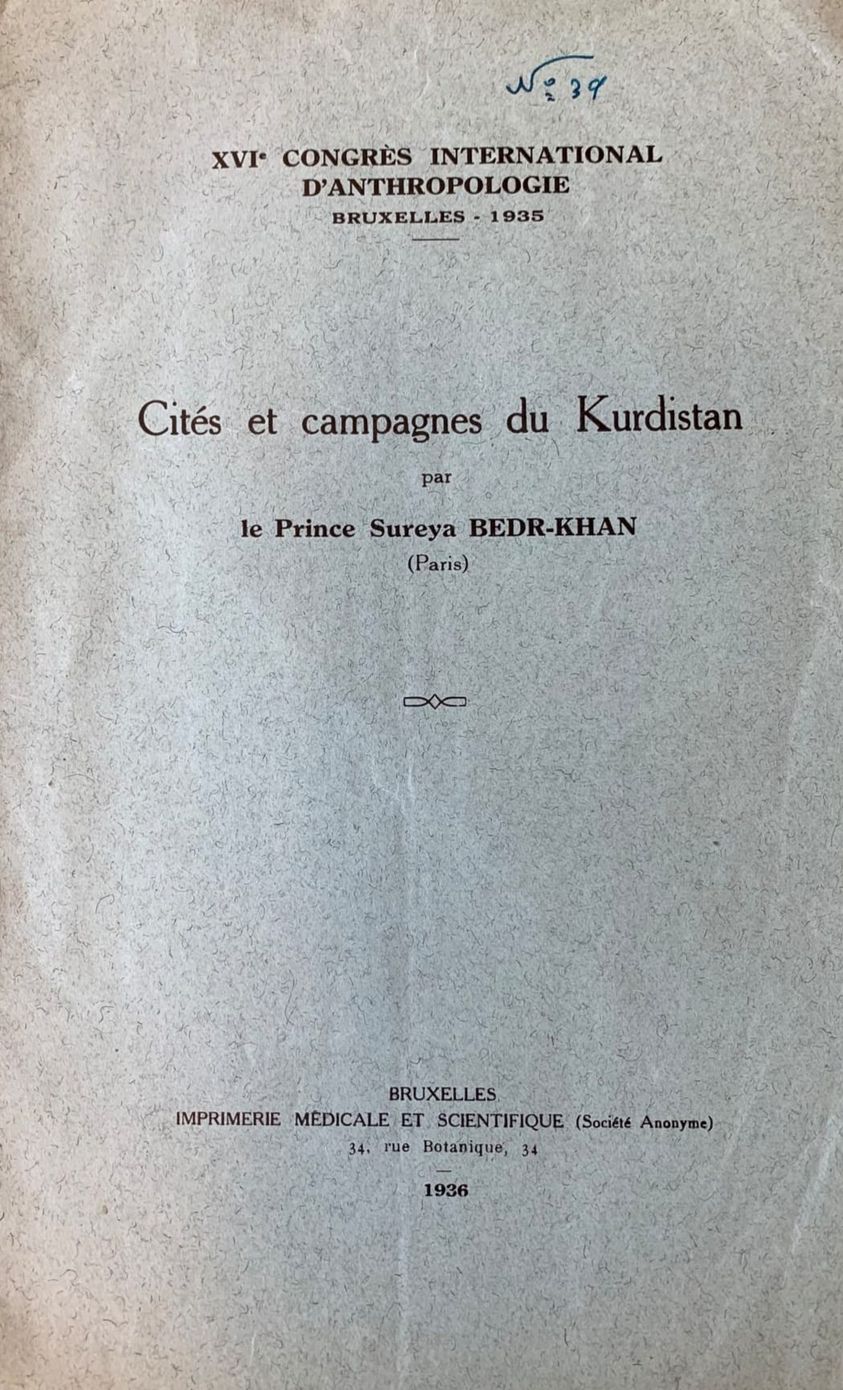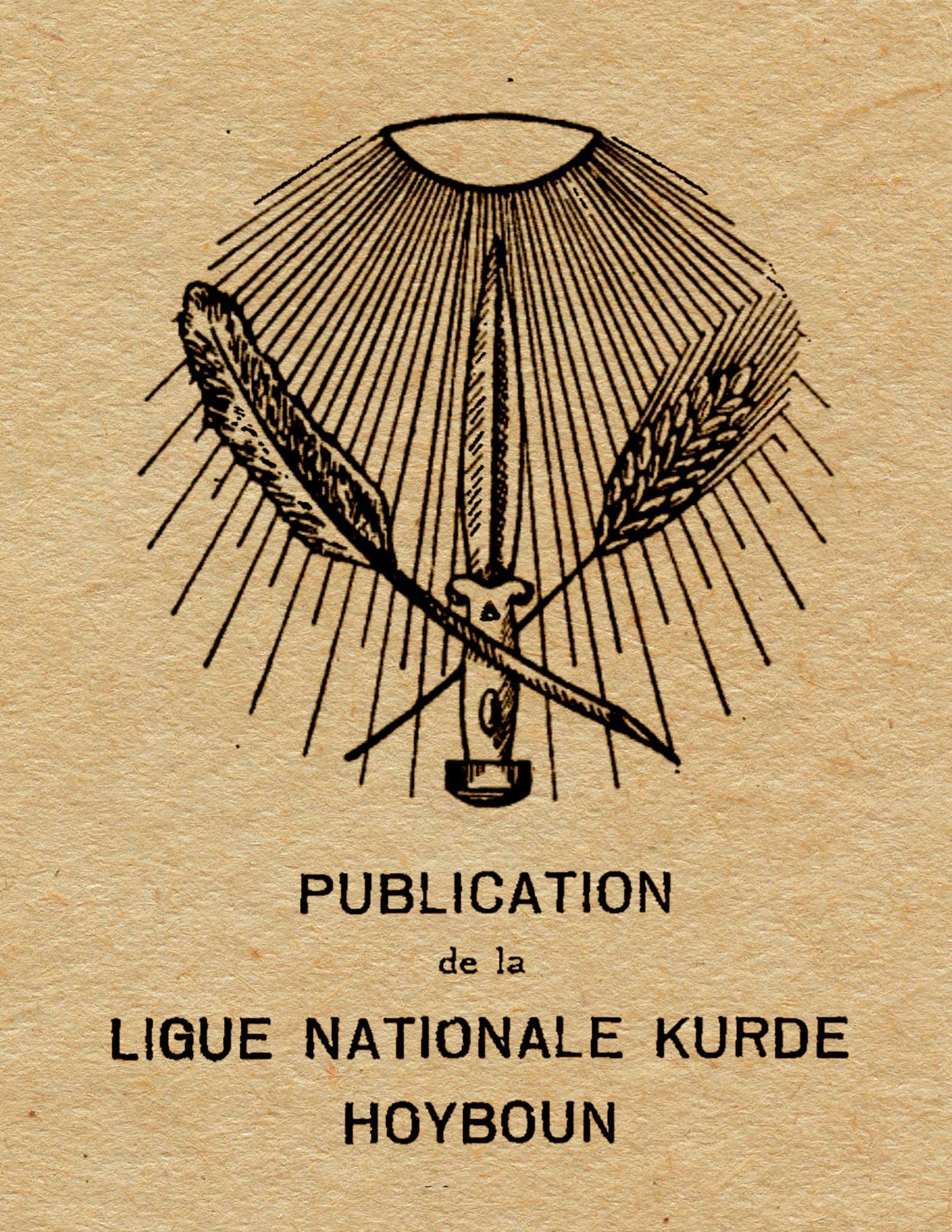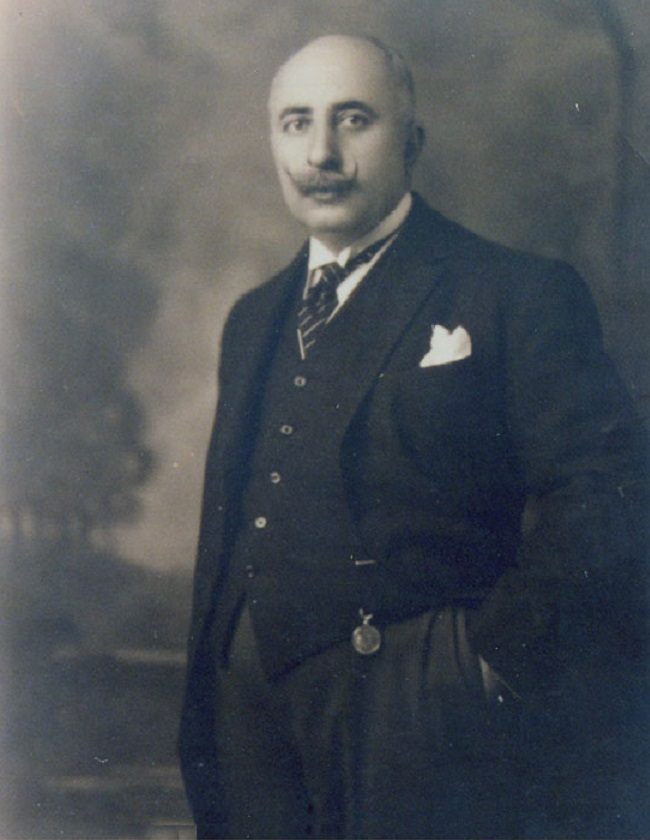
XOYBÛN
(Serxwebûn)
INDEPENDENCE

Prince Sureyya Bedir Khan
Sureyya Bedir Khan (1883-1938) The Kurdish Prince, a descendant of the Kurdish dynastic family Bedir Khans.
He was an influent fighter of Kurdish independence, a scholar (agronom) and author (pseudonym: Dr Sherko Blech) of several books.
THE
CASE OF KURDISTAN AGAINST TURKEY
by Prince Sureya Bedir Khan
First Edition: Philadelphia, 1926, USA
Second Edition: SARA Bokförlag, 1992, Stockholm SWEDEN
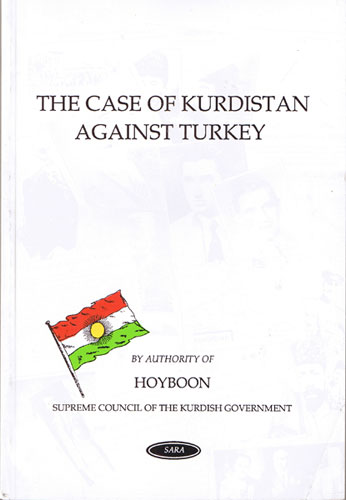
by Prince Sureya Bedr Khan
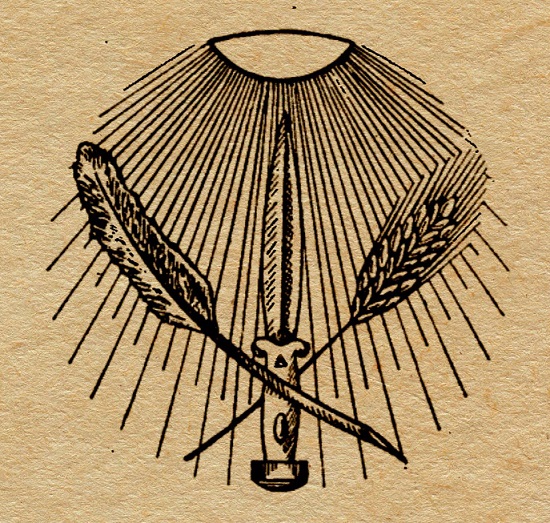
Xoybûn, bir kongre olarak ilan edilmeden önce Şamda bulunan Mir Celadet Ali Bedirxan ile (sonradan katılan) Osman Sebrî,
Kobanîde bulunan Berazî mirleri
Mustafa (Hirço) ve Bozan Şahin Bey kardeşler ile Hama miri Necîb Axa Berazî tarafından
5 Ekim 1927'de Lübnan'da kurulmuştur.

Much of the organized propaganda for Turkey--Old and New--as distinguished from
amateurish prattle, reflects necessarily the varying interests of the propagandists.
The Italian press but yesterday condemned vociferously Kemal's pretensions and
ridiculed his innovations; today, with the signing of a treaty which promises
Italy certain economic advantages in Turkey, it professes with equal zeal admiration
for the courage and far-sightedness of Kemal. The American missionary also,
a short time ago only, could see no hope for the Turk who, in ten years, had
annihilated over ninety-five per cent of the gains attained by the missionary
in a hundred years. But today the same missionary meekly and with apparent sincerity,
even at the price of a complete denial and abandonment of his primary purpose,
accepts employment under Turkish direction, and has become the Turk's most zealous
apologist and advocate before the world. We may not altogether agree with the
wisdom and morality of these violent and artificial changes of attitude, but
we can at least understand the motives of the actors. (2)
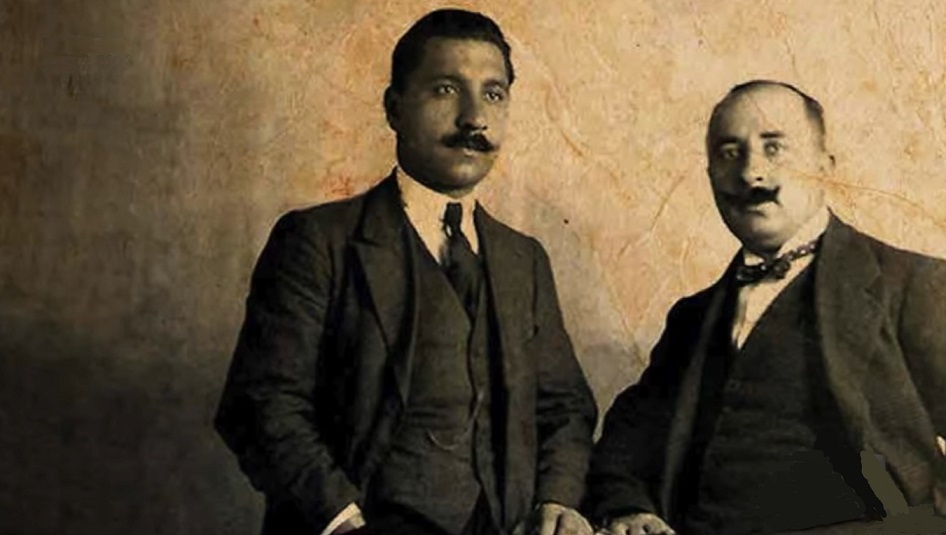
Du bra: Mîr Celadet Alî & Mîr Sureya Bedirxan
Turkey Today
That sort of propaganda, however, can neither help the Turk nor alter the essential
facts. From a far-flung empire, with an area of over 1,600,000 square miles
and an estimated population of 45,000,000 in 1842, Turkey has shrunk to a mere
shadow of her former self--320,000 square miles in area, with an estimated population
of 5,500,000. More than one-half of this Turkey is in a state of complete desolation,
deserted, in heaps of ruins, a veritable No Man's Land. The overwhelming majority
of her people, of whom perhaps 3,500,000 are Turks, are steeped in deep ignorance,
subject to hopeless, abject poverty, waiting fantastically for something to
happen that may perhaps improve their unbearable lot--or end it. They care not
whether they are made to wear a fez or a hat, nor whether Kemal adopts the Latin
alphabet or the Swiss Code. Their only concern is that those racial elements
which hitherto furnished them bread and loot are no longer there, and they themselves
lack the initiative, intelligence and the means to keep body and soul together.
Taxes are nearly three times higher today than before the War; the cost of living
about two and a half times greater, but the scale of wages, which hovered at
around starvation point even before the War, is either at a standstill, or in
spots perhaps fifty per cent higher. In the Province of Iconium, the agricultural
center of Turkey, nearly 300,000 peasants are in the grip of famine, and in
the region of Harpoot, where a workman, if he should be fortunate enough to
find work, can earn no more than 25 cents a day, sugar is 50 cents a pound,
and bread 20 cents. These are typical instances of the general misery of the
people throughout Turkey. (3)
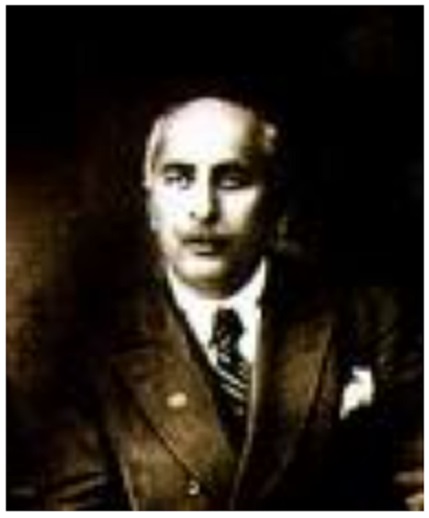
The "budget" of the Government is fixed arbitrarily at $95,000,000;
but the revenue, in reality, is barely two-thirds of that, and over one-half
of the revenue used for the army. Bribe taking commonly known as Bakshish--an
almost legalized institution in pre-war Turkey--is today practiced even more
methodically and systematically than ever before. The Turkish official must
eat.
In an effort to distract attention from this tragic condition of things, much
noise is made by a few hundred Gallicized Turks, and especially interested foreigners,
about the so-called reforms, which exist chiefly on paper, and isolated attempts
at reconstruction.
A few miles of military railways have been constructed; a number of new buildings
have been put up at Angora and Constantinople; some tractors, motors and other
machinery have been imported; but these haphazard gestures only compel the conclusion
that Kemalist Turkey possesses neither the brains nor the resources to realize
the aims and ambitions of its spokesmen. (4)
The pretensions as to Kemal's military and diplomatic successes and capacities
are equally misleading. True, Kemal conquered a Greek army which refused to
fight, and, also he overcame the Armenian Republic of Erivan. But in the autumn
of 1922, he dared not cross the line defined at the Dardanelles by General Harrington,
who commanded a force of only 20,000 men. The policy of tolerance which the
Allies pursued at Lausanne, and are still pursuing, was dictated solely by certain
provisions of the treaty of alliance between Angora and Moscow. One of these
provisions is that, under certain conditions, the Bolsheviki will lend military
help to Turkey. Kemal knows too well that it would be quite a risky thing for
him to be rescued by the Reds, yet a drowning man clutches at a straw. The Allies
fully realize the possible consequences of pressing Kemal too hard because,
if the Reds should once enter Turkey, it might be quite difficult to dislodge
them. That is the sum total of Kemal's alleged military power. It is also the
secret of his arrogance.
The inevitable process of economic and physical disintegration is now taking
plce in Turkey. An examination of the Kurdish problem will shed much light upon
the background and ultimate issue of this process.
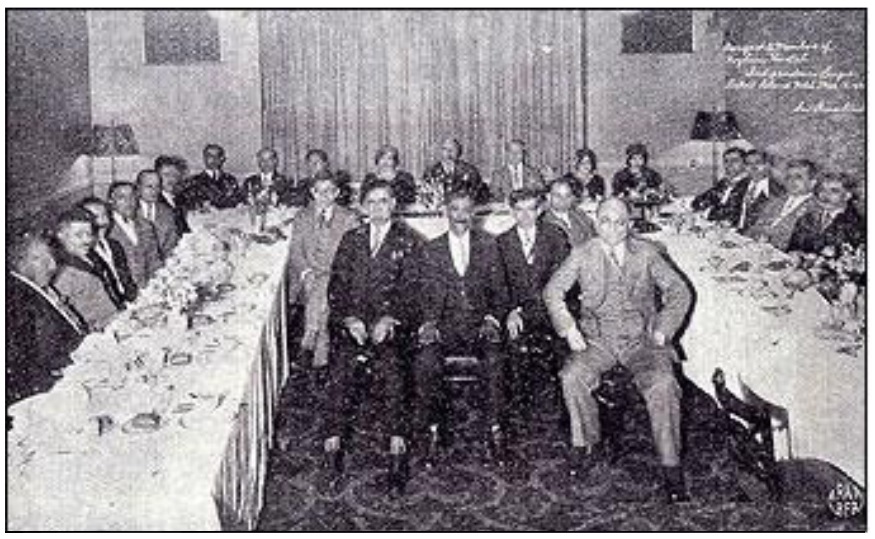
Kurdish meeting in US at 1927s
Li gor rojnameya Zarya Vostoka; ku li Tiflîsê derdiket, Komîteya Pêşîn a Kurd li sala 1929'an de li bajarê Detroît'ê li Amerîkayê hatiye damezirandin.
Yê serê jorê li nîverastê rûniştî û derstmala sipî li bêrîka jorê ya çakêta wî, divê Mîr Sureya Bedirxan be.
Turks' Policy Toward Non-Turks
The Turks' policy toward the non-Turks--Greek, Armenian, Kurd, Serb, Arab and
others--from the beginning to cause and a common purpose ... That policy is
fixed and directed by a realization of his own physical (numerical) inadequacy,
his economic sterility and inability to survive. In consequence, by the natural
urge of self-preservation, he has sought to make up and supplement his native
defects in these respects by the pacific or forced assimilation of other races
and by loot. Deprived of these two artificial sources of life, the Turks as
a ruling race would long since have died out from inanition.
Heredity, training, religious fanaticism, intrigue, provocation, and what not
have been and may again be offered in explanation of the Turk's outbursts of
savagery. In reality, the root of all these abnormal manifestations has been
and is the desire of the Turk to strengthen and sustain his race--by the abnormal
means of forced accretions.
Most races seek and have sought to live and to grow through normal processes--with
due regard to the rights of others. In this respect, the Turk is perhaps the
only exception in the annals of history; he has so far maintained his ranks
and has recruited his racial ranks by drawing upon others, quite regardless
of their rights. Considerations of morality aside, the status of the Turk in
the civilized world is both extraordinary and anomalous. Even the Turkish chauvinist
now realizes that the life of the parasite can last no longer than that of his
victims, and he is today faced for the first time, with the grim, cruel law
that his life is strictly limited to his own capacity and ability to reproduce
and produce.
Since this is the crux of the Turk's problem, of which the Kurdish problem and
the Armenian problem are only by-products, the subject deserves further elucidation.
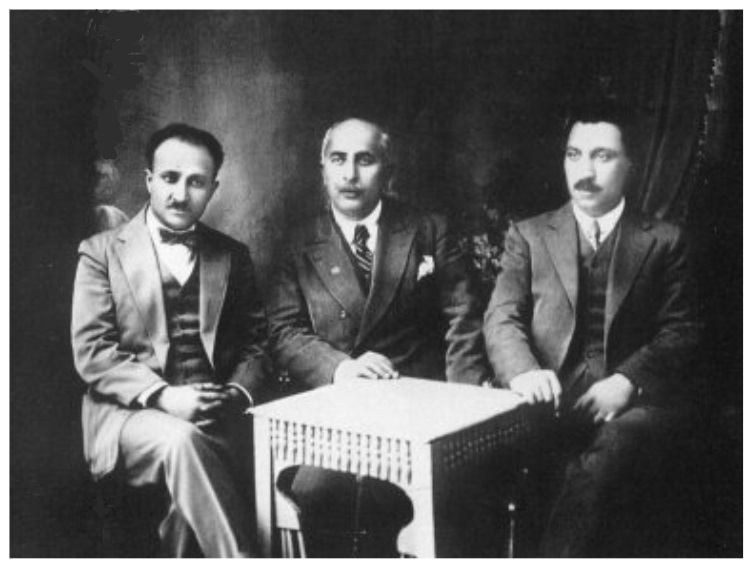
Sê bra Kamûran, Sureya û Celadet
Rise and Decadence of the Turk
The course of Turkish history, down to the rise of the Young Turks, has been
marked by three main stages. It has now entered the fourth, and perhaps the
last, stage.
A review of the physical and political development of the Turk will show that
his great adventure--a mere prowling jaunt in the beginning--gradually grew
into an organized industry, under such euphonious titles as Sultanate, Empire
and Republic, from the earliest times always motivated by the necessity and
the purpose to enslave or to annihilate, to loot or to absorb. It will also
reveal the fundamental cause of his unending troubles with the non-Turks on
one hand, and the hopelessness of his latest attempt at survival on his own
account on the other.
A Mongolian, his habitat in Central Asia, the Turkish race comprised many millions
of predatory tribes, under the leadership of irreconcilable chieftains. One
of these tribes, as early as the third century, had established a great State,
reaching from Manchuria to India. In the eighth century, this State fell under
the rule of the Arabs. (5) The Turks then embraced Islam and, through pacific
assimilation, increased their numbers and power, and placed men of their own
race on the Arabian throne.
Later, the Seljuks, another Turkish tribe, entered this Arab state, now under
the overlordship of their kin, absorbed it to the extent of exploiting its resources
for their own purposes, and, in the middle of the eleventh century, had extended
their rule over Persia, Mesopotamia and Syria, to the very edge of the lands
which bear today their racial title--Turkey.
This is the first stage of Turkish history. During this period--nearly 700 years--as
down to our own day, the Turk increased his numbers by pacific or, at need,
forced assimilation, always depending for his own economic wants upon loot and
the labor of those who fell under his power.
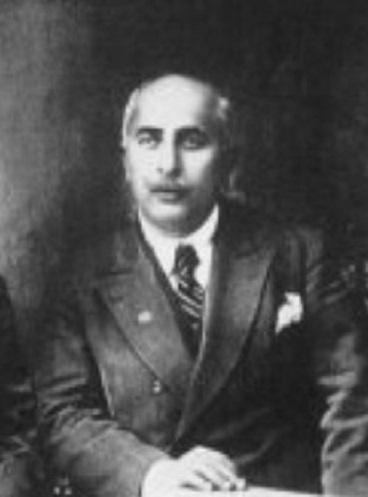
Turkish Tide at Vienna--and Back
We enter the second stage of Turkish history. The Turk was now in military control
of Persia, Mesopotamia and Syria. Gathering under his banner motley legions
of adventurers, mercenaries and renegades from many lands and climes, and with
the virility and desperate courage of the brigand, reinforced by religious zeal
and lust for booty, the Turk set out to gain the mastery of Asia Minor.
The whole of Asia Minor, from Ararat to the Dardanelles and from the Black Sea
to the Mediterranean, soon became his field of operations. At the extreme end,
there was the little Armenian Kingdom of Ani, which was soon to succumb to Byzantine
treachery and Mongol assaults (1046), to be replaced (1080) as the home of the
Armenians by the Cilician (6) Kingdom along the Mediterranean, which survived
till 1375. All through the rugged mountain chain, from Ararat to the Amanus,
on the western edge of Syria, was held by the Kurds, under numerous chieftains,
whose sole concern was the protection of their tents and homes. Beyond this
thin Kurdish curtain, which screened off the Seljuk Turks from their objective,
lay Asia Minor, populous and stored with dazzling riches, governed by pleasure-loving
effete politicians, in the name of Byzantium. (7)
Between 1048 and 1071, while the armies of Byzantium were struggling in the
northwest against the Slavs, the Seljuk Turks, methodically and persistently,
worked their way into Asia Minor. They murdered whole populations; enslaved
and carried away unnumbered girls and children; and looted and lay waste as
far as their dominion reached. The Mongol Turk who, during the first stage of
his westerly progress, had assimilated the Semitic Arab, now began to assimilate
the Aryan Greek.
In 1971, Alp-Aslan, the Seljuk, inflicted a crushing defeat on Emperor Diogenes
of Byzantine at Manazguert, in the region of Van, and then pushed his way almost
to the very edge of the Sea of Marmora. It was in 1288 that the Ottoman Turks,
under their leader, Ertogrul, number 444 tents, who had entered the domains
of the Seljuks in 1257, were granted a tract of land at Sugut, midway between
Angora and Brusa, and subsequently, fell heir to the estate of Alp-Aslan, the
Seljuk Turk.
The passing of power from the Seljuks into the hands of the Osmanli Turks was
accomplished without serious friction. Apart from the racial and religious kinship
and common schooling, the Osmanlis found themselves under the same necessity
to pursue toward the non-Turks the policy of their predecessors.
The Turk murdered to overcome opposition, to terrorize and to weaken his subjects;
he forced multitudes to embrace Islam; he filled his harem with the girls and
women of almost all the races which fell under him.
Orkhan, the second Sultan (1326-1359), by law, decreed that Christian families
should deliver to the State, as a special tax, male children between the ages
of 7 and 10. In 1453, when Mahomet captured Constantinople, he massacred or
enslaved the whole population. Suleyman, in 1526, in one of his fifteen invasions
of Hungary, massacred 200,000, and enslaved 100,000. Serb, Arab, Greek, Kurd,
Armenian, Albanian, Circassian, from the beginning of the Turk's rule to this
day, have been compelled to furnish their quotas of flesh and goods toward the
preservation and sustenance of the Turk. It is extremely doubtful if ten out
of a hundred of present day Turks, now numbering about 3,500,000 can trace their
ancestry back to the invading Turkish race.
It is likewise remarkable that the overwhelming majority of Turkish leaders,
generals and statesmen, and all the Sultans, following the tenth Sultan, have
been and are either renegades or of mixed parentage. Mahomet's Admiral, who
captured Constantinople, was a renegade Bulgarian. Talaat, Turkey's war-time
Grand Vizier, was a Bulgarian Pomak, and his two immediate predecessors--Shevket
and Prince Halim--were Arabs. Mustapha Kemal is the grandson of a renegade Croat
from Nish. Ismet, his Premier, is a Kurd from Rafan, and so is also Fevzi, his
former Premier and now Chief of Staff, a Kurd from Tarjan; Reouf, another of
Kemal's Premiers, now an exile, is a Circassian. Indeed, renegades, the endless
internecine strife of conquered races and the jealousies interse of the great
nations are what have made possible the success of the Turk and the preservation
of his power to this day. Kemal's success, albeit temporary, is due to the conflicting
interests of the Principal Allies of Western Europe and to the support of the
Reds. (8)
How, then, it may be asked, can we account for the survival of millions of non-Turks,
if the Turk was bent upon murder, forced assimilation and loot as essential
guarantees of self-preservation? The answer is that the Turk's policy toward
the non-Turks was limited by both his power and his opportunity as well as by
considerations of self-interest.
When Mahomet captured Constantinople he massacred and enslaved the whole population;
but he allowed the Greek and Armenian to conduct the business of the nation
and engage in productive pursuits for the wants of the State. Greeks, at some
places, notably in Crete, were never completely subjugated. In the mountains
of Sassoon and Zeitun, even down to our own day, the Armenian maintained himself
in a state of rebellion. The Serb fought the invader in the Black Mountains;
the Albanian mountaineer never bowed to him. The Kurds, up to a century ago,
never allowed his Zapties and tax gatherers within the precincts of Kurdistan,
and even today he holds fringes of his soil against the pretensions of Kemal.
The main and the specific point which I desire to stress is this: From the beginning
of his career to this day, the Turk increased and replenished his numbers by
drawing upon other races, and he maintain his State and himself by robbery and
brigandage. He never built, and never produced. Limited to his own capacities
and resources, he must, naturally and inevitably, succumb.
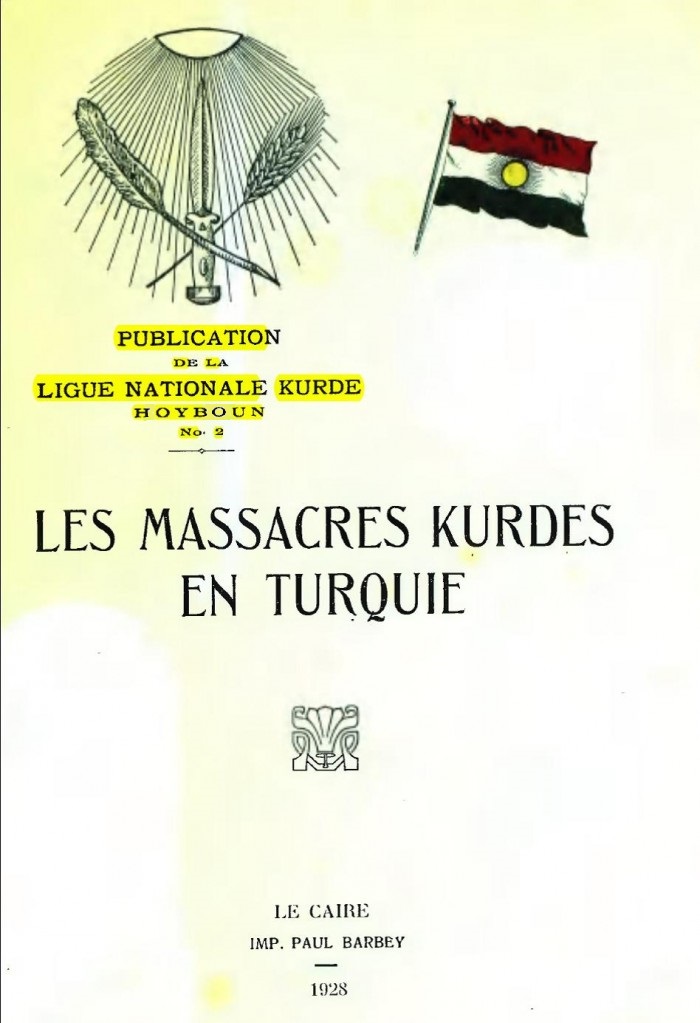
From Vienna to the World War
The almost uninterrupted westerly advance of the Turkish tide was beaten back
at the gates of Vienna in 1683, and in 1774 Turkey suffered even a greater defeat
at the hands of Russia, and was compelled to accept the first humiliating Treaty
(at Kutchuk-Kainardji), which granted Russia the right to be interested in the
lot of the Orthodox subjects of the Sultan. The Turk was now on the defensive.
In this third stage of Turkish history, the problem that faced the Turk, insofar
as it concerned his treatment of the non-Turk and his own problem of self-preservation,
took on a new and more serious character.
The Turk was in a hopeless minority, in a sea of hostile races, in an alien
world. He was now faced by two aggressive, powerful foreign States--Russia and
Austria, and, later, by England and France as well. The subject races in Turkey
no longer submitted meekly to the cruelty and exactions of the Government. Not
only were they now conscious of their own ability to protest and resist, and
of the inherent weaknesses of the ruling Turks, but they could now look to the
Great Powers for help and protection.
On the other hand, if the Turk granted his subjects their just demands for equality
and freedom, they would gradually assert economic and political independence;
but, if he did not not, he would then drive them to rebellion, and court the
intervention of the Powers.
The Turk, therefore, resorted to a policy of deception and bribery--a policy
which is still today the very foundation and life of Kemalist Turkey. Between
1774 and 1913, the Turk agreed, in twenty-one international documents, to inaugurate
reform measures in this or that section of his realm, and he changed the form
of his government nine times. He bought off nations with gold and concessions,
and by playing upon their conflicting political and economic interests.
Tactics or duplicity, however, only retarded the inevitable course of events.
One race after another broke loose from Turkish grip. From the high tide of
his power to this day, races numbering nearly 80,000,000, in Europe, in Asia
and in Africa, have thrown off his yoke.
With the accession of Abd-ul-Hamid to power in 1877, the Turk found himself
in the necessity of adopting a different national and international policy for
his own preservation. Hamid believed, even as Mahomet, conqueror of Constantinople,
that the non-Turk was the mainstay of the Turkish State; he also believed the
chief danger to his throne lay in the ever-recurring interferences of the Powers.
The foundation of his internal policy was to make lavish promises of reforms,
which he would not and could not fulfill, and he sought to ward off the aggression
of the Powers by an appeal to the sentiment and influence of Islam, as Califf.
This new policy of Pan-Islamism served the purpose of England in holding Russia
in leash; but it had no influence whatever upon the subject races in Turkey.
Rebellions became the order of the day--in Albania, in Arabia, in Macedonia,
in Cilician Armenia--and the futility of half-measures to satisfy the subject
races and the impossibility of holding together much longer this heterogeneous
mass known as Turkey, became clear to the ruler and subject alike.
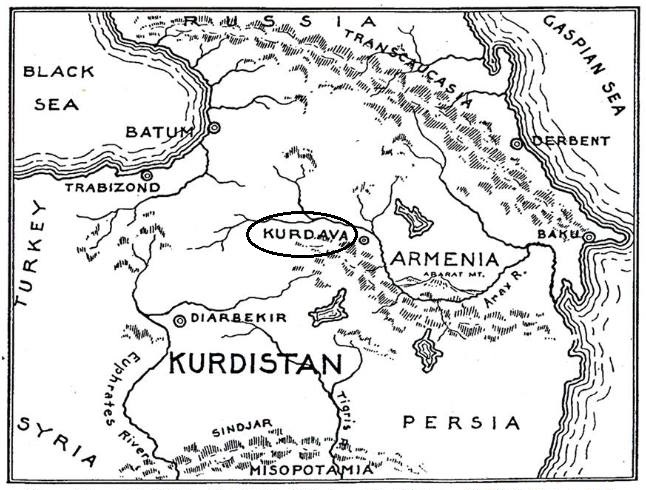
Young Turks in Power
The Young Turks, now known as Kemalists, attained power in 1908, with the avowed
purpose of preventing, if possible, the then threatened dismemberment of Turkey.
We need not here discuss the value, much less the earnestness, of any of their
professions of fraternity, equality, etc. We then knew the hidden aims and convictions,
which were to shape their policy toward the non-Turks, and which they have since
tried to put into execution.
According to the Young Turks, Pan-Islamism was an asset of questionable value:
even the Moslem Arab, Kurd and Albanian frowned upon it, and cherished separate
ambitions. The subject races would not be satisfied with reform measures, and,
furthermore, such reform measures would be more to the advantage of the non-Turk
than that of the Turk. Elimination of the non-Turk was the only sure guarantee
of removing at once the cause of internal disorders and rebellion as well as
of foreign interferences. But the elimination of the non-Turk would also destroy
the racial elements upon which the Turk had heretofore drawn to increase and
replenish his ranks and for his economic existence. It was, therefore, necessary
for them to join hands with the Turco-Tartars (Turanians) beyond Turkey--in
Persia, in the Trans-Caucasus and beyond the Caspian. S, for Hamid's Pan-Islamism,
they substituted Pan-Turanism. (9)
Young Turk Kemalist Policy Toward Non-Turks
The Young Turks entered the world war with the purpose of putting this policy
into execution. (10)
In 1914, there were four principal racial elements in Turkey: Arabs, Greeks,
Armenians and Kurds. Expediency and opportunity determined the time and form
of action with regard to each of these races.
While the Greek was looked upon as an element of disturbance and as nursing
separatist ambitions, even as the Armenian and Kurd, the latter two races had
one additional drawback of separating the Turk from his Turanian kin in Persia,
in the Trans-Caucasus and beyond the Caspian.
The Young Turks destroyed, during the war, about a quarter of a million Greeks;
about 200,000 Lebanese; executed scores of Arab leaders, and deported nearly
700,000 Kurds, of whom all but one-half perished. But the full force of their
vengeance fell upon the Armenian. They murdered nearly one-half or a million
of the Armenians in Turkey and enslaved over a hundred thousand girls and children.
With the defeat of the Central Powers, the Arabic portions of Turkey--Mesopotamia,
Arabia and Syria--broke loose from her rule. Then Mustapha Kemal took up the
task of carrying into completion the plan of his former associates in the matter
of ridding Turkey of the non-Turks.
Taking advantage of the dilatory policy of the Allied and Associated Nations
in liquidating the Turkish problem, and with the active help and connivance
of certain Powers, particularly, of Bolshevist Russia, Kemal set up a military
dictatorship.
Kemal destroyed, between 1919 and 1923, nearly 750,000 Greeks. Of the pre-war
Greek population in Turkey, estimated at a minimum of 2,500,000, about 1,380,000
found refuge in Greece and there are now no more than 100,000 Greeks remaining
in Constantinople. He destroyed or expelled all but 100,000 of the surviving
Armenians, and he undertook a fierce war of extermination upon the Kurdish people,
culminating in the Kurdish revolution of 1925, and the subsequent declaration
by Kurdistan of her independence and the state of war, which has ensued between
Turkey and Kurdistan.
I will now address myself to the task of presenting the Kurd and his case.
The Kurd--Race and Tongue
The Kurd, or Gordyene, the aborigine of his present-day habitat from time immemorial,
is now recognized, like the Portuguese, Spaniard, South Italian and many Persians,
as a member of the Mediterranean branch of the Caucasian of Aryan family.
About 1,000 B.C. northern Aryan groups penetrated as shepherd colonies through
the Caucasus range into the State of the Medes, bringing along with them their
Aryan tongue and their Zoroastrian faith. They called themselves and their tongue,
Parsee or Pharsi. In the 6th Century, B.C., they had imposed their racial title
and tongue upon most of the Medes, and, in 538 B.C., under the leadership of
Cyrus, they organized the Parseeian or Persian Empire. During the reign of Darius
(485 B.C.), most Medes had become merged with the invading Persians.
The pressure of the conquering Persians upon the Medes for centuries drew the
Kurd and Mede into closer sympathy and contact, and the subsequent fusion of
the Persian and of most Medes resulted also in the merging of many Medes with
Kurdish tribes, and in the ultimate disappearance of the Mede as a separate
racial entity.
The Parthian, also, like the Mede, was largely absorbed by the Persian, and
partly by the Kurd. With time, the blood of the Persian invader became almost
completely assimilated with allied strain of the Mede and of the Parthian. The
racial kinship between the Kurd and the Persian of today is thus traced to the
Mede and the Parthian, merged in the Persian and the Kurd.
The tongue of the Persians, Old Persian, is closely related to Zendic, an Iranian
language, and to the Sanscrit of Hindustan. The Old Persian ceased to be a living
tongue about 4th century B.C., but from it are derived the Modern Persian, Pehlevi
or the Parthian, the Medic and the present-day Kurdish dialects. (11)
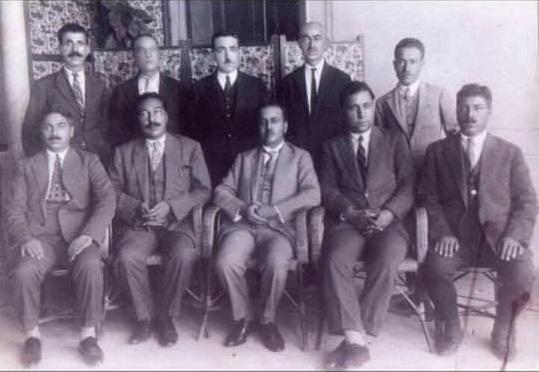
Early History
The Greeks perhaps gave the Kurd his racial name. Herodotus refers to the Kurds
as a warlike people, the descendants of Carduques, who hindered the retreat
of Xenophon's ten thousand (401-400 B.C.).
The Kurds called themselves GUTUS, which signifies warrior. In the Assyrian
cuneiform inscriptions, there are references to them as GARDANS, KARCTANS, OR
CARDACS and they are classed together with such important contemporary races
as the Hittites, the Elamites and the Asdekians of Babylonia.
The tribe has always been, as now, the unit of the Kurdish race. Scores of tribes,
much like the clans of the Scots, have managed, with varying fortunes, to maintain
semi-independence or local autonomy under Cyrus and Xerxes, the Macedonians,
the Parthians, the Arabs, and the Turks.
At times, their power grew into mighty states, and they imposed their rule upon
neighboring races. Before the dawn of Islam in the 6th century the Kurdish tribe
of Gauran under Goatanza, their chief, founded a great state embracing the present
Persian Tabriz, and beyond, with its capital at Kirmanshah.
The sweep of Islam, however, in the 7th and 8th centuries, (12) gathered in
its momentum not only the Kurd's political power, but also influenced profoundly
and materially altered his faith and his moral code, ultimately to his association
with the Turk, and his inevitable debasement and misfortunes in consequence.
(13)
The rule of the Arab over conquered races was a mild, almost benevolent, despotism;
the Arab, however, was at the same time the crusader of a new religion, and
he forced the Kurd to abjure and abandon his ancestral pagan faith, and accept,
instead, Mohamedanism. He also compelled the Kurd to give up his own alphabet,
and to use, instead, Arabic characters. (14)
This violent and abnormal change in the cultural life of the race naturally
produced a bewildering confusion of speech and dialects among the tribes and
in the end resulted in the decadence of Kurdish letters.
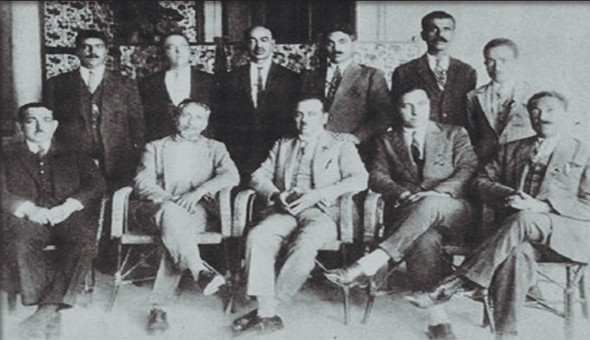
Rêza rûniştî ji milê rastê ve: Mustafa Şahîn beg, Mîr Celadet Bedirxan, Dr. Şikrî Segban, Vahan Papazyan û Memdûh Selîn Begê Wanî
li Beyrûdê sala 1927an, li kombûna ji bo damezirandina Xoybûnê
Kurds' Height of Power
[GRAPHIC OMITTED]
But not even the might of the Khalifs of Bagdad, nor the kinship of faith which
now existed between the Kurd and Arab, could long keep the Kurd in subjection.
Between 888 and 905 many Kurdish tribes rose in rebellion against the domination
of their Arab rulers, asserting their independence.
In the XIIth century, Salaheddin (Saladin), the Conqueror, established the vast
empire of Eyoubi. He challenged Richard the Lion Hearted and destroyed Richard's
armada. The power of the Kurd at that time extended as far as Khorassan in Persia,
Egypt, and the western limits of Syria.
During the intermittent Tartar and Mongol invasions of the Near East in the
14th and 15th centuries, the Kurds enjoyed a period of welcome peace and quiet,
while Turk and Persian were engaged in an ever-growing sectarian quarrel, which
was to determine also the political destiny of the Kurd.
It is perhaps one of the greatest tragedies of Kurdish history that Persian
and Kurd, sprung from a common racial stock professing a common faith, and enjoying
a common social and cultural inheritance, could not bridge the chasm of a minor
sectarian difference, which divides them. The Persians are Shiite Moslems, and
the Kurds, Sunni Moslems. (15) The antagonism and distrust, wholly purposeless
and unnecessary, which this sectarian discord created and nursed between the
two races, soon became the cause of their humiliation and of unending misfortunes.
Kurds and Turks Enter into Treaty
In 1514 the mighty Sultan Selim I of Turkey undertook his campaign for the subjugation
of Shiite Persia, then under the rule of Shah Ismail. The road that led to Persia
was held by semi-independent and powerful Kurdish tribes. The Kurds could hardly,
therefore, remain neutral in this religious conflict; they had to choose between
the Sunni Turk--their own sect--and the Shiite Persian. They threw in their
lot with their co-sectarians, the Turks.
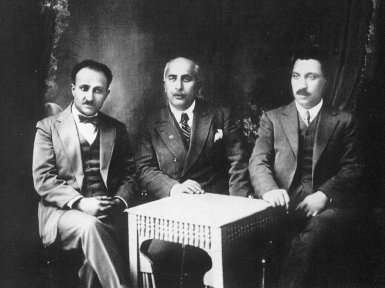
The victorious Turkish Sultan, on his way back from his Persian expedition,
was lavishly feted by Kurdish tribal chiefs. He gave assurances to them of his
solicitude and respect for their independence. The Kurds, deeply impressed by
the bravery and magnanimity of Selim, offered him a political and military alliance.
Thus, in 1514, there was concluded between Turkey and twenty-three Kurdish States
a Treaty of Amity and Alliance, drafted by Idris, a Kurd, and approved and signed
by Selim, of which the following is the substance:
I. All existing, signatory Kurdish States will retain their full independence.
II. Succession will pass from father to son, or shall be regulated according
to the laws of the country, the Sultan recognizing the legitimate successor
by Imperial firman.
III. The Kurds shall participate in all wars by Turkey.
IV. Turkey shall assist the Kurdish states against foreign aggression.
V. The Kurds will contribute customary religious gifts (something like Peter's
Pence) to the Purse of the Khalif.
Turks Violate Treaty
For over one hundred and fifty years, following the Treaty of 1514 between Turkey
and the Kurdish States, the Kurds faithfully fulfilled their obligation to Turkey.
They took part in all the wars of Turkey--wars of offense and defense--and sacrificed
tens of thousands of lives.
But the Turks, as usual, failed to keep faith. Plunder and enslavement have
always been the mainspring of Turkish actions, and intrigue and the scimitar
the instruments of their rule.
No sooner was Sultan Suleyman beaten back at the gates of Vienna in 1683 than
he set himself to a campaign of intrigue and treachery in the Kurdish States,
designed to stir hate and disunion among them. Without apparently interfering
with their independence, Suleyman arbitrarily designated a Governor General,
who was to make his headquarters at Diarbekir, and was to be the intermediary
between the Kurdish States and Constantinople.
Thereafter, the policy of "Divide and Conquer" was followed with its
usual success. Gradually, but surely, the Turkish invader, equipped with an
inexhaustible supply of pretexts, seized the Kurdish States, and made them into
Provinces. By the middle of the nineteenth century, during the rule of Abd-ul-Medjid,
the Turk had annexed to his dominion almost all of the Kurdish lands, allowing
the tribal chiefs only a mere nominal autonomy.
In 1847, Prince Bedr Khan, ruler of Djezireh, the strongest remaining Kurdish
State, was challenged by the Turkish Sultan to a test of authority. The Turkish
armies, numbering over 100,000 men, suffered disastrous defeats at the hands
of Bedr Khan; but Bedr Khan succumbed to the treachery of his own cousin, and
the last remaining seat of Kurdish independence fell to the Turks.
Since that time the Kurdish people, without a shepherd, and broken into many
and irreconcilable factions, have been persecuted and bruised, and subjected
to a thousand wrongs at the hands of the Turk. (16)
Before the World War, religion was the common denominator of the nationality
and nationalism in Turkey. To the Turk, there were only Moslems and Infidels.
The Turk called himself "Moslem," not "Turk." He was the
ruling race, and any race which enjoyed, with the Turk, the common patronymic"
of Moslem was marked off from the rest of the people and enjoyed certain exclusive
privileges, and performed certain duties, which were neither granted to nor
imposed upon the others.
The Turk carried arms. His main concern was to hold in check and exploit the
conquered races, particularly the non-Moslem. He reserved to himself the task
of soldiering. The "infidel" was not allowed to carry arms, and he
was exempted from military service in consideration of a nominal head tax.
The Kurd, however, shared the rights and duties of the Moslem Turk and also
many of his limitations and his weaknesses. The constant and ever increasing
exactions of military service depleted the Kurd's manpower; made of the woman
an animal of burden; hindered and smothered the productive effort of the Kurd;
demoralized and degraded his cultural life, and dragged him down to the low
level of the Turk. (17)
Throughout this process of suppression and oppression to which the Kurd was
subjected in common even with the Turk, he, unlike the Christian, had neither
the right nor the opportunity to complain of his lot, either to the Government,
which was nominally at least his own, or to the world. His lot was in fact even
more cruel than that of the Turk because the Turkish ruler used him as his agent
against the Armenian, 18 and as the agent he had to bear the greater part of
the indignation and the contumely aroused throughout the world by this savage
course, perpetrated at the instigation of an for the benefit of the Turk. It
was primarily the Kurd who was denounced before civilization as a marauder and
murderer.
Following the Armenian massacres of 1894-96, under the inspiration of Abd-ul-Hamid,
a group of Kurdish leaders came at last to a realization of the disastrous effects
of misguided religious fervor upon their people, as well as of the folly and
the infamy of the Turk's Pan-Islamic policy. These Kurdish leaders felt that
if the Kurds should continue much longer to serve as a pawn and an instrument
in the hands of a mad and unscrupulous ruler, they would not only forfeit forever
the right to appeal to the conscience of mankind, the civilized world, but that
the Kurdish people, even as the Turks, would seal the doom of their existence.
A short time before the advent of the Young Turks in 1908, Kurdish leaders started
a movement looking toward the disentanglement of Kurdish life from that of the
Turk, and the restoration of the cultural and national ideals and independence
of the Kurdish people.
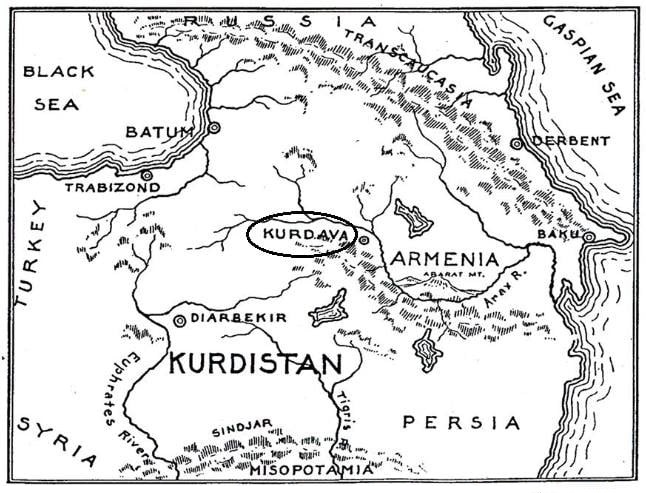
Young Turks' Kurdish Policy
In 1907, the edifice of the Turkish State was tottering. A few gallicized Turks,
who called themselves "Young Turks," and who had found refuge in Europe,
appealed to Armenians, Kurds, Greeks and Macedonians, to make common cause in
an effort to overthrow the Hamidian tyranny, and to set up a constitutional
regime founded upon the principles of equality fraternity and liberty.
In the historic Congress of Paris in 1907, a pact was made between the Young
turks and the leaders of the oppressed nationalities in turkey to realize the
high aims professed by the Young Turks. The uprising of Salonika, in July 1908,
was the outcome of the common efforts of the representatives of these various
racial groups which joined in the Pact of Paris. On July 24, 1908, Hamid was
forced to proclaim a constitutional system of government, and the reins of power
passed into the hands of the Young Turks.
But no sooner had the Young Turks attained power than they brazenly repudiated
the pledges of the Pact of Paris. They now made it clear that while they did
not believe in the efficacy of the Pan-Islamic policy of Hamid--although they
were ready to exploit Islam world opinion in favor of Turkey--the foundation
of their policy toward the non-Turks was the Ottomanization or Turkification
of the Non-Turks. They would enforce that policy by assimilation, if possible;
by elimination, if necessary.
From 1908 to 1914 they pursued that policy. In the case of the Moslem Kurd,
they tried the policy of assimilation; in the case of the Armenian, that of
elimination. But the pace was too slow to satisfy them. They entered the World
War primarily to fulfill the Turkification or the elimination of the Kurd, Armenian
and Greek.
This policy was the first step toward Pan-Turanism. Once rid of racial problems
within the bounds of Turkey, they planned to reach out beyond the frontiers
of Turkey and join hands with the Turanians or Turks of Persian and Russian
Azerbaidjan, as well as with those beyond the Caspian.

XOYBÛN [khoyboon] Congress, 1927 Libanon
Kurds During the War
The story of the tragedy of the Armenian people during the War is well known,
and need not be rehearsed here, except that the deportation of nearly three-fourths
of the two million Armenians who lived in Turkey in 1914, and the massacre and
enslavement of nearly a million of them, were parts of a pre-conceived and calculated
plan, designed to eliminate the Armenian as an inassimilable element in Turkish
life and stumbling-block in the path of the Turk toward the execution of his
pan-Turanian adventure.
The failure of the Dardanelles expedition freed the Turk, for the first time,
from the influence and restraint of European opinion. It also rendered available
detachments of troops and irregulars, which were promptly employed to execute
the plan of Armenian extermination, or to put down the Armenians' resistance
at five or six localities.
Turks Deport 700,000 Kurds
Under these conditions, the Young Turks undertook the "assimilation"
of the Moslem Kurd at first through pacific processes. They prevailed upon the
accommodating Sultan Khaliff Rechad V. to sign a decree, which provided for
the deportation of the Kurdish people from their ancestral homes and their settlement
among the Turks in Western Anatolia, in proportion of 10 Kurds to 100 Turks.
The two races professed a common faith and the Kurds would now be compelled
to speak Turkish, and, according to the authors of this crime, the second Kurdish
generation would become thoroughly Turkified.
Before proceeding to the mass "assimilation" thus planned, the Turks
tried out the process first by deporting groups of Kurdish notables. They discovered,
much to their surprise, that the Kurds were just as averse to becoming "assimilated"
as the Armenians. Losing patience, they therefore decreed for the Kurds the
fate of the Armenians.
The Register of the Director General of Emigration in Constantinople discloses
the ghastly fact that in 1915 the Young Turks deported 700,000 Kurds from Kurdistan
to Western Anatolia. Girls, women and children of tender age were enslaved by
the thousands; hunger, disease and privation exacted a terrible toll on the
long caravans of these helpless human beings; heaps of corpses and of the dying
filled many ditches and dotted the whole line of this colossal crime upon the
life of the race. Not even one-half of these unfortunates reached their destination.
No one knows how many of them survive today. The extermination of the Kurd had
now become a settled and avowed policy of the Turk.
Kurds Fight for Turks
At the outbreak of the War, most Kurds of military age were drafted into the
Turkish army. In the absence of any means of communication with their home folks,
they were kept in complete ignorance of the plans and acts of the Turkish Government
in Kurdistan. Also, the Government was prosecuting a vigorous anti-Armenian
and anti-Christian campaign among the Kurdish regular and irregular troops.
The real or artificial antipathy of the Armenian for the Kurd had long been
deeply rooted and sedulously cultivated in the Kurdish mind by Turkish propagandists.
The Young Turks now told the Kurds that the Armenians had made common cause
with the Allies; that only a month or so before the entry of Turkey into the
war, the Armenians of the Trans-Caucasus and of Turkey had entered into a written
agreement with Russia, whereby Russia would help them in the invasion and conquest
of Turkish Armenia and of Kurdistan, and that quite naturally the Armenian would
exact a terrible vengeance from the Kurd for past wrongs, etc.
This sort of propaganda was impressive and convincing. It won the Kurdish fighter
to the side of the Moslem Turk. In thus playing into the hands of the Turks,
the Kurds suffered terribly both physically and morally, and contributed greatly
to the destruction of their own fortunes and homes, and to their present plight.
After the Armistice
During the last days of October '9'8, the ring-leaders of the Young Turk camarilla
saw the handwriting on the wall, and they turned the Government over to a "pro-ally"
group, Reouf Bey, who subsequently became Kemal's Premier, signed for Turkey
the Armistice of Moudros with the Allies. The Articles of the Armistice provided
expressly for terms of peace, including the expulsion of Turkey from non-Turkish
regions, which the Allies, in conformity with their war-time pledges, proposed
to impose upon Turkey.
Turkey lay prostrate. 19 The wartime Turkish army of 1,200,000 men had now shrunk
to 50,000 men, with about 150,000 desertions. Arabia, Mesopotamia, Syria and
Palestine had already been cut off from the Empire; the region east of the Euphrates
had been practically denuded of its Turkish population as of its Armenian population;
the Government had almost ceased to function in Asia Minor, and the central
Government in Constantinople was soon to fall into the hands of the Allies (March
1919).
Prompt and honest action by the Allies would have liquidated, once for all,
the problem of the Turk and should have ended the agony of those whom the Turk
had oppressed for a thousand years. But misguided and uninformed humanitarianism,
or unwarranted meddlesomeness, was to destroy once again the hopes and prayers
of the ages, and to offer the wily Turk a fresh opportunity to reassert himself--for
a while longer.
American Intervention Disastrous for Oppressed Races
For the first time in history, the Allied Powers were really honest in their
professions of redeeming the Armenian, Kurd, Arab and Greek from the incubus
of Turkish misrule. The Allies who, by the secret treaties of 1915 and 1916,
had cut up turkey into spheres of influences, were now willing and ready at
the hour of victory to recognize the national rights of the inhabitants concerned.
In his opening speech on January 19, 1919 at the Versailles Conference, the
President of France said that "... the rights of the oppressed, of the
victims and of the martyrs ... shall be vindicated ..." The Allies, in
full recognition of the general chaos that obtained in Turkey, were determined
to settle the Turkish problem before they undertook the consideration of the
more complicated terms of general peace.
The Turkish case, therefore, was taken up in February 1919. At the invitation
of the Conference, a Kurdish Delegation, headed by General Sherif Pasha, like
the Armenian Delegation, presented the Kurdish case. The Armenian Delegation
claimed considerable territories, extending from the Black Sea to the Mediterranean,
which were to be united with the then existing Armenian Republic (Russian Armenia),
and in view of the depleted and disorganized condition of their people and country,
a request was made for provisional financial and physical aid.
Whereupon the President of the United States, who was intensely interested in
the then proposed League of Nations, and obviously believed that he interpreted
the sense of sympathy felt by the American people for the Armenian people, intervened,
and advised the Peace Conference that American would be glad to lend Armenia
the help she needed--if and when America joined the League. At the same time
he requested the Conference to defer action upon the Turkish case.
The sincerity and magnanimity of the President of the United States could not
be questioned; the Allies could not, without inviting upon themselves the suspicion
of the world, proceeded with the matter at issue; but the delay which the American
action imposed upon the Allies resulted, as was fully expected by informed persons,
in the subsequent intrigues amongst the Allies, the resurgence of Kemal, and
in the appalling tragedy that overtook Kurd and Armenian alike. (20)
Kemal Appears on Scene
No sooner had the Conference pigeonholed the Turkish case than the Turks and
their agents moved into action. Americans played the leading role in the events
that followed. American residents of Constantinople, and particularly most missionaries,
were averse to the dismemberment of Turkey. They felt that the proposed independent
Armenia and Kurdistan, and a revived Hellenism, might, and in all probability
would, bring to an end their attempts at proselyting and close out what had
come to be a very large business with tremendous property interests; whereas
Turkey, as it then stood, and the Russian Trans-Caucasus, under American control,
would become a happy hunting ground both for possible converts and economic
concessions. Gates, Bristol and others became the most violent propagandists
for an American unitary mandate, and Dr. Gates carried a private letter from
Talaat Pasha, chief organizer of Armenian massacres, to the American Peace Mission
in Paris, advocating an American unitary mandate for Turkey, etc. The Turks
knew full well the utter impracticability of the scheme, which they apparently
favored; but they were playing for time. They were well aware that the proposal,
if carried into effect, would destroy the prestige and position of the Allies
in the Near East, and they knew also that even the possibility of the consideration
of the proposal would stir up discord amongst the Allies, and force them to
a policy of "sauve qui peut." They were right.
In May 1919, Brigadier-General Mustapha Kemal Pasha left Constantinople for
Anatolia, ostensibly as Inspector of the non-existent Third Turkish Army, but
in reality to organize resistance to the Allies. Simultaneously, Turkish agents
started to flirt with France and Italy with some success. The arrival of Kemal
in Anatolia coincided with the seizure of Smyrna by the Greeks. Great Britain
sponsored this movement. The Greek action enabled Kemal to improvise a nondescript
force of about 35,000 men by August, 1919. He established his headquarters at
Sivas, where General Harbord, about a month later, paid Kemal his respects.
At this time Kurdish leaders, fearful of the course of events, held a meeting
at Kahta, near Malatia, and organized a force designed to arrest Kemal's adventure.
Unfortunately, however, there arrived then at Malatia Col. Bell, chief of the
British Intelligence Service at Aleppo, who, in the name of his Government,
advised the Kurds against any warlike operations, and reassured them of the
settled purpose of the Allies to solve the Kurdish case in accordance with their
war pledges.
There can be no doubt but that the Kurds were then more than able to crush Kemal,
as the Armenian Republic of Erivan could easily have occupied Turkish Armenia.
But both the Kurds and Armenians committed the unpardonable folly of giving
full value to the words of the Allied and Associated Nations. Had these two
races known then, as they know now, that the basis of international diplomacy
is the fait accompli, and that international "morality" is as yet
an empty platitude, they would have saved themselves all their subsequent misery.
Kemal Joins Moscow
The British support of Greece in the matter of Smyrna definitely broke up the
Allied front against Turkey. Italy was intolerant of Hellenic expansion in Western
Asia Minor and France exploited the opportunity to secure for herself certain
economic concessions from the Kemalists.
In the meantime, Turkish emissaries established contact with Moscow; Enver,
Kutchuk, Talaat, Halil Pasha, Behaedin attended, in the late summer of 1919
the Congress of the Eastern Peoples at Baku, which was presided over by Zinoviev.
Here the Turk and the Bolshevik agreed upon a plan against the "imperialistic"
Powers, the first part of which was the elimination of the Armenian Republic
from their path. This agreement was later embodied in another, signed in Constantinople
on November 29, 1919, and later in a more definite and comprehensive treaty,
which was signed at Erzerum on April 15, 1920. (21)
In the face of this threatening danger, the frantic and pitiful appeals of the
Armenian Republic to the Allied and Associated Nations for arms and munitions
for self-defense fell on deaf ears. The latter sent only Committees and Commissions
of Inquiry, and addressed notes of warning to the Kemalists, while Mr. Balfour
characterized Kemal in the House of Commons as a plain "bandit."
It should here be noted that the Kemalists and the Bolsheviki, who were without
the pale of international law, might perhaps justify themselves in resorting
to common action against those whom they recognized as their enemies. But the
stupidity, sordid greed and negligence and irresponsibility of the Allied and
Associated Nations, can neither be explained nor excused. They stand guilty
of a willful crime at the bar of history.
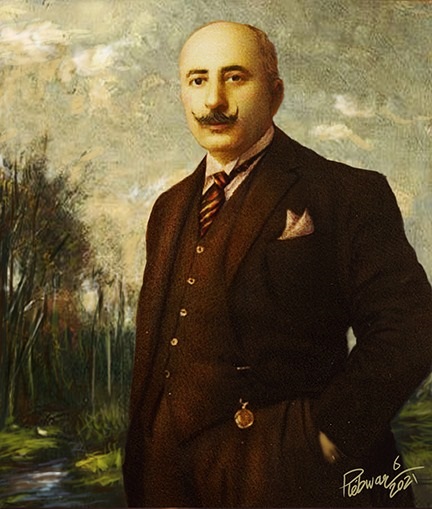
Prince Sureyya Bedir Khan by Rebwar K. Tahir
Kurdistan in the Sevres Treaty
Under these conditions, the Allies met at San Remo in April 1920, and agreed
upon the terms of the treaty to be made with Turkey. This Treaty was subsequently
signed at Sevres on August 10, 1920.
At this time, the Armenian Republic (Russian Armenia), which had been set up
in May, 1918, was already recognized by the Allied and Associated Nations. The
Sevres Treaty provided for the allotment of certain lands in Turkish Armenia
to the Armenian Republic, the boundaries of which were to be defined by the
President of the United States.
The Treaty of Sevres also provided for a Kurdish State. The three Articles,
concerning Kurdistan, read as follows:
SECTION III KURDISTAN
Article 62
A Commission sitting at Constantinople and composed of three members appointed
by the British, French and Italian Governments respectively shall draft within
six months from the coming into force of the present Treaty a scheme of local
autonomy for the predominantly Kurdish areas lying east of the Euphrates, south
of the Southern Boundary of Armenia, as it may be hereafter determined, and
north of the frontiers of turkey with Syria and Mesopotamia, as defined in article
27, II, (2) and (3) If unanimity cannot be secured on any question it will be
referred by the members of the Commission to their respective Governments. The
scheme shall contain full safeguards for the protection of the Assyro-Chaldeans
and other racial or religious minorities within these areas, and with this object,
a Commission composed of British, French, Italian, Persian and Kurdish representatives
shall visit the spot to examine and decide what ratifications, if any, should
be made in the Turkish frontier where under the provisions of the present Treaty,
that frontier coincides with that of Persia.
Article 63
The Turkish Government hereby agrees to accept and execute the decisions of
both the Commissions mentioned in Article 62 within three months from their
communication to the said Government.
Article 64
If within one year from the coming into force of the present Treaty the Kurdish
peoples within the areas defined in Article 62 shall address themselves to the
Council of the League of Nations in such a manner as to show that a majority
of the population of these areas desires independence from Turkey, and if the
council then considers that these peoples are capable of such independence and
recommends that it should be granted to them, Turkey hereby agrees to execute
such a recommendation, and to renounce all rights and title over these areas.
The detailed provisions for such renunciation will form the subject of a separate
agreement between the Principal Allied Powers and Turkey.
If and when such renunciation takes place, no objection will be raised y the
Principal Allied Powers to the voluntary adhesion to such independent Kurdish
State of the Kurds inhabiting that part of Kurdistan which has hitherto been
included in the Mosul Vilayet.
While this Treaty was being signed at Sevres by the representatives of the Principal
Allies and by those of Turkey and Armenia, Kemal and Moscow were at work to
thwart its execution.
Kemal Attacks Armenia
In May and June, 1920, Bolshevist uprisings took place in several districts
of Armenia, which the Government suppressed. In June, Moscow sent an ultimatum
to the Armenian Republic, demanding the passage of Bolshevist troops over Armenian
railways to join hands with the Turks. Armenia rejected it. Refusal of a second
ultimatum in July was followed by invasion in August.
Simultaneously therewith, Kemal attacked the Armenian Republic, but was repulsed.
Then, in the latter part of September 1920, a reinforced Kemalist army, under
Kiazim Kara Bekir Pasha, moved upon Armenia from the southeast, while Soviet
troops invaded her from the northeast. On December 2, 1920, the Armenian Government
was ousted; it returned in February 1921, but was driven out of Armenian soil
by Bolshevist bayonets in July, 1921. (22)
Kemal had now established direct contact with the Bolsheviki, who furnished
him generously with arms, munitions and gold.
By the Treaty of 1921 with France, Kemal had been relieved from further pressure
in Cilicia; Italy maintained a "benevolent neutrality," and Kemal
now could turn his undivided attention to the Greeks, who had remained unwisely
quiescent while Armenia was being attacked.
[ILLUSTRATION OMITTED]
Political divergences at home, dissensions amongst the Allies, and other factors,
had destroyed the morale of the Greek army. The Greeks made one serious thrust
at Kemal and then they quit. Kemal reached Smyrna without any serious resistance.
He covered 185 miles in 15 days. On September 13, 1922, Kemal ordered the destruction
of Smyrna, and here was enacted one of the most revolting crimes of all history.
Over 100,000 men, women and children were put to the sword or were burned to
death, and over 25,000 girls were enslaved. The story of the tragedy of Smyrna
is well described in a recent book, "The Blight of Asia," by George
Horton, former American Consul General in Smyrna.
The breathing spell, which America offered the Turks, gave Kemal his chance,
with the active aid of Moscow and of two other Powers, to effect the repudiation
of the Treaty of Sevres. From Smyrna, Kemal went to Lausanne to negotiate a
new treaty. Here, backed by Moscow and America, he faced the Allies, no longer
united, who made no secret of their anxiety to patch up any kind of a treaty.
Lausanne Conference, Mosul Oil, and Kurdistan
"AND they crucify Him, and part His garments among them, casting
lots upon them, what each should take."--Mark 15:24
The Lausanne Conference was an unprecedented gathering of concession seekers,
honest brokers and humanists, for the allotment among themselves of the bodies
and properties of flocks of timid and trusting sheep, denominated as Armenians,
Greeks, and Kurds. With customary ponderous solemnity, the spokesmen of the
august assembled nations played their hands according to the program, and each
nation pocketed the precise loot it coveted.
Curzon was deeply distressed, while Barrere and Garoni affected mournful faces,
over the wrongs suffered by the Armenians. Ismet grinned, and promised to think
of some remedy, and, after consultation with Richard Washburn Child, he allowed
him to advocate for the Armenians a "refuge" in turkey, and then Ismet
generously offered the whole of turkey as a "refuge" for the Armenians--provided
that they would behave themselves! The Kurds likewise received some "sympathetic
mention," as also the Assyro-Chaldeans, and so on.
But for a correct appraisal of the Lausanne Conference, it is necessary to state
the specific objectives which the principal participating nations sought--and
obtained.
Two points, at least, should first be made clear. One is that no nation wanted
or needed to resort to force to secure its objective. Turkey herself was weak,
but she was backed by Russia, glad of a chance to make trouble for England,
and also, thanks to the intervention of America, Turkey held the trump card
of the Mosul oil.
The second point is that the prize loot, in which England, America, France and
Turkey claimed a share, was oil--situated in a region predominantly inhabited
by Kurds. This oil was the national inheritance of the Kurdish people.
What Each Nation Sought and Obtained at Lausanne
Turkey came to Lausanne with the fixed purpose of securing freedom of action
by the abrogation of the capitulations and international sanction to her Pan-Turanian
scheme, namely, the elimination of the Greek, Armenian and Kurd.
The price she would offer for this franchise was acquiescence in the secession
of the Arabic-speaking districts of Mesopotamia, Syria and Arabia from her rule.
Insofar as the oil-bearing Mosul area was concerned, which was now included
in Mesopotamia, all that Turkey hoped was to blackmail a share out of the concessionaires.
The Kemalists had long ago decided against the inclusion of the Mosul region
in Turkey--because its vigorous Kurdish population might, or perhaps would,
interfere with the execution of the plan of extermination of the less compact,
although more numerous, Kurds, who were already in the grip of the Turks. Furthermore,
upon no conceivable ground could Turkey put forward a valid claim to Mosul oil.
As early as 1904, this property was in the Privy Purse of Sultan Abd-ul-Hamid,
who then gave an option contract for its survey and exploitation to the German
Anatolian Railroad Company, and later, in 1908, to the English D'Arcy Exploration
Company. In 1909, the Young Turk Government retransferred this same property
to the Ministry of Mines, but, on June 28, 1914, a Young Turk Grand Vizier,
by letter, reconfirmed Abd-ul-Hamid's option contract, in favor of the Turkish
(British) Petroleum Company, now the successor of the German Anatolian Company
and D'Arcy Exploration Company.
It is true that at Sen Remo, on April 24 1920, Great Britain and France, by
the so-called "Petroleum Agreement," allotted 20% pro rate of the
Mosul oil to the native Government of Iraq, which was the suzerain of the region
of Mosul; at the same time, at San Remo, and later in the Sevres Treaty of August
10, 1920, this oil-bearing Mosul region was recognized by the Allies as part
of the proposed Kurdish State, and was therefore, both in law and in equity,
the property of the Kurds. In consequence, if the grant by Turkey to the Turkish
(British) Petroleum Company in 1914 was valid, then it could not be reopened;
but if it was not, then the Mosul oil-bearing region was, and is, the rightful
property of the Kurds. (23)
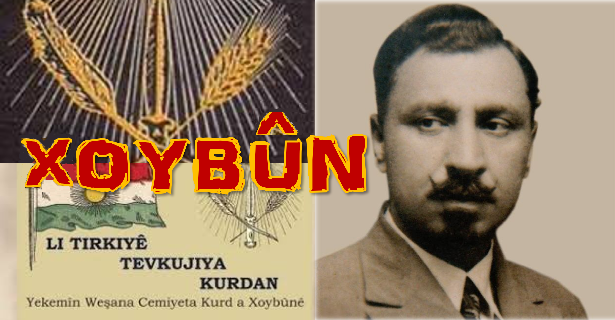
America's Role at Lausanne
But, as early as the fourth day after the opening of the Lausanne Conference,
on November 25, 1922, America intervened and injected into the conference, oil--Mosul
oil--and thereafter, oil determined the fate of the unfortunate Greeks, Kurds
and Armenians.
America reopened the Mosul oil contract. She challenged its validity, and then
claimed a share in it upon the so-called principle of Open Door.
When America thus injected herself into the Lausanne Conference, the Turks,
who had already indicated their willingness to validate all the pre-war contracts,
including the Mosul oil grant, now made a volte face, and welcomed America as
a God-sent collaborator in the promotion of their schemes. In this they were
not disappointed. America delivered to the Turks the Armenian case, the case
of the protection of minorities, and the capitulations as well. The Turks, in
consideration of this vital help, declined to validate the Mosul oil grant,
and allowed America a chance to get in on the ground floor.
America ultimately obtained a one-quarter share in Mosul oil--the precise thing
she had gone to Lausanne to get. That America, having determined victory for
the Allies in the war, was undeniably justified in claiming a share in Mosul
oil--if oil was to be treated as spoils of war--without either bribing the Turks
or without betraying her moral obligations, is a question which need not be
here discussed.
The fact is that once America sided with the Turks, the Allies almost gladly
conceded to the Turks their demands at the expense of their own pretended wards.
The surviving Greeks and Armenians were ordered to leave Turkey. The Kurdish
case was abandoned and forgotten; and the boundary between Armenia and turkey
was left undefined.
In the matter of the capitulations, as of control of Turkish finances by the
foreign creditors, the Allies only made perfunctory protests and reservations,
to save appearances. They yielded to Turkish pretensions in these matters because
they knew that, sooner or later, a weaker Turkey would be compelled to seek
a loan, and then the foreign creditors would have a chance to impose their terms
upon her.
The Allies themselves obtain, like Turkey and America, all they wanted. Great
Britain secured, through her mandate over Iraq, a land route to India, a continuance
of control over the Suez Canal, a vast cotton empire in the Soudan, and a share
in Mosul oil. France also obtained a share in Mosul oil, and consolidated her
position and prestige in the Near East through a mandate over Syria. Italy maintained
her occupation of the Greek Dodecanese Islands. The concessions which these
nations made to the Turks were at the expense of others--of Kurds, Greeks and
Armenians. The Sevres Treaty was "revised" only as against these latter
three races, in the absence of and without the consent of Armenians and Kurds.
Kemal's Kurdish Policy Since Lausanne
Kemal was now free to carry into effect his Pan-Turanian scheme. All the surviving
Greeks and Armenians, except about 200,000, were expelled, and he then turned
his attention to the remaining Kurds, in an effort to complete the plan of ridding
Turkey of non-Turks. (24)
He started the campaign against the Kurds by requiring the Kurds, under penalty
of death, to speak Turkish; by deporting scores of Kurdish notables; by seizing
unnumbered Kurdish girls and women; and by inaugurating a general reign of terror,
in all parts of Kurdistan into which his agents could penetrate. At the spectacle
of this ghastly decimation of their people, Kurdish leaders, with the infamy
of Lausanne still fresh in memory, turned to the only honorable course that
was open to them--revolution.
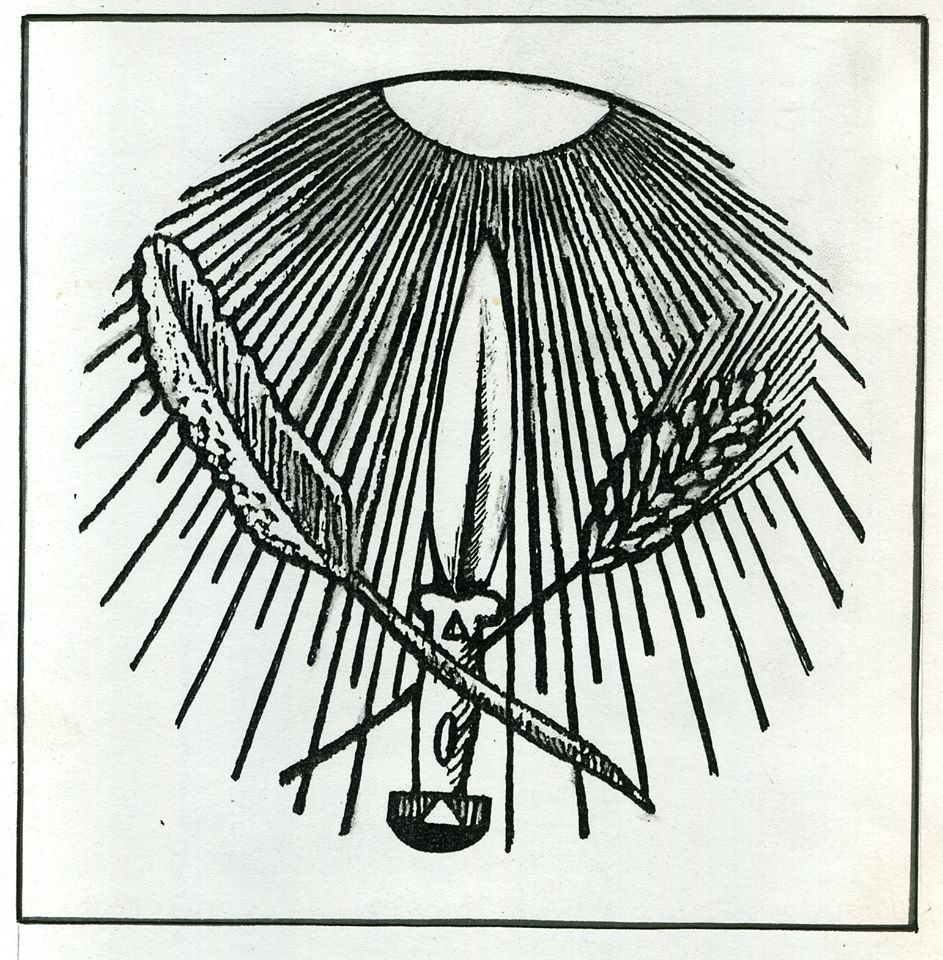
Logo of The Hoyboon (Independent) Organization
Kurdish Revolution of 1925
The Kurdish people, now harried and hounded like criminals by the Kemalists,
responded gallantly and eagerly to the call to arms. Under the leadership of
Sheik Said of Piran and a staff of veteran officers, an army of over 50,000
was organized under cover; munition depots were established at strategic points,
and a general uprising was set for March 21, 1925, which was to drive the Turks,
bag and baggage, out of Kurdistan. But luck once again was on the side of the
Turks.
The Turks already had some inkling of Kurdish activities, and their spies and
emissaries were at work. In the first days of March 1925, a Kurdish patriot
carelessly visits Sheik Said at his home, and, on leaving, is taken quietly
to the Turkish headquarters a few miles beyond--and questioned. He, of course,
denies knowledge of any proposed Kurdish uprising, and insists that he had visited
the Sheik to ask for a teaching position. The Turkish Commander, thereupon,
addresses a courteous communication to Sheik Said, inviting him to the headquarters.
The Sheik, now aware of the experience of his Kurdish visitor, and suspecting
a foul plot at the hands of the Turkish Commander, summons at once his few hundred
bodyguard to rise. Thus prematurely the Kurdish revolution started on March
7, 1925, instead of March 21, 1925, as planned.
Unfortunately, there were practically no wire communications between the Kurdish
units, and the action of Sheik Said could reach them only through long and uncertain
channels, offering the Turks the opportunity to isolate and surround the attacking
forces.
The Turks sent against the Kurds the 9th Army Corps of Erzerum, the 8th Corps
of Erzinjan, and the 7th Corps of Diarbekir. The Kurds inflicted decisive defeats
upon the enemy, and advanced to Ourfa, Severek and Diarbekir, capital of Kurdistan,
occupying the southern section of the latter city. They were successfully pressing
the Turks in every direction. (25)
Then suddenly a terrible calamity overtook the Kurdish fighters. A fresh Turkish
army of 25,000 transported over the Syrian railways, in accordance with the
terms of the Franklin-Bouillon agreement of 1921, appeared in the rear of the
Kurds. The Kurds were thus caught between two fires. Their plan of campaign
was made upon the natural assumption that Syria, Iraq and Persia would remain
neutral.
Undaunted, however, by this Turkish coup, the Kurds fought with the courage
of desperation. The Turks brought fresh troops from Kars, Trebizond and Sivas.
After four months' struggle, the Kurds realized the hopelessness of a regular
warfare, and fell back upon a guerrilla war which is still continuing.
In the course of this unequal contest, the Turks suffered heavier losses than
those during their entire campaign against the Greeks. Their casualties exceeded
50,000 and the cost of the operations amounted to over 60,000,000 Turkish pounds.
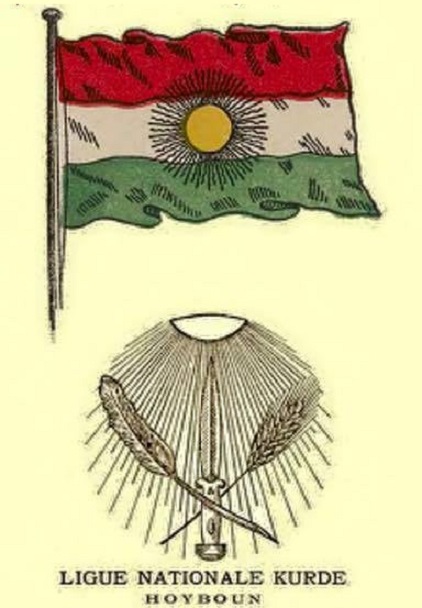
Kurdish Rebellion in Force
The Kurdish forces were then formed into units of varying sizes, and assigned
to certain districts, as follows:
Egri Dagh 2,000
Dersim 5,000
Sassoon 6,000
Chapak-Achan 2,000
Vartan 2,000
Moosh-Bitlis 4,000
Manazguert 1,000
Mazi-Dagh 1,500
Silvan 1,000
24,500
In addition to these formations, which have been put through some necessary
changes in personnel and strength since 1925, there are now four other strong
mobile units engaged solely in raiding operations.
Following the reorganization of the Kurdish plan of campaign, the first step
was the selection of a site for headquarters and Government. Egri Dagh, midway
between Persia and the Armenian Republic, was selected. By decisive actions,
the Kurdish troops cleared the regions, embracing some 300 villages of Turks,
and set up there the headquarters of the Kurdish Government, which has since
directed the Kurdish operations, fighting many successful battles against the
Turks since 1925.
The Kemalists, during 1926, now enraged at the audacity and "impudence"
of the Kurds, struck a sharp blow at Egri Dagh, the headquarters of the Kurdish
National Army, and suffered a humiliating defeat. The Turkish Commander, 15
staff officers and 800 men fell into the hands of the Kurds, and over 2,000
dead and dying Turks littered the field of battle. The Kurds also captured 20
cannon, 66 machine guns, 1,200 rifles, 300 bomb throwers and other booty.
Kemal again tried his luck against Egri Dagh on December 15, 1927. An infantry
regiment of the 9th Division of the Caucasus sallied forth from Igdir, to be
smothered, however, under a rain of Kurdish fire. Four Kemalist officers, a
score of men, 2 pieces of cannon, 15 machine guns, and considerable munitions
fell into the hands of the Kurds. On January 31, 1908 [1928?] a Kurdish force
seized the Motki-Bitlis road. Several enemy battalions from Moosh, kara-Klisse
and Van soon engaged the Kurds. After three days' struggle, which centered at
Delikli-Tash, in the gorge of Bitlis, the Kurds carried a decisive victory.
The Turks fled, abandoning on the field of battle over 400 casualties, including
15 officers, cannon, machine guns and quantities of small arms and munitions.
On February 4, 1928, a squadron of Turkish battleplanes attempted the bombardment
of the Kurdish headquarters at Egri-Dagh. Two Turkish planes fell within the
Kurdish lines, and the others sought safety in flight--never to return.
On March 29, 1928, a Kurdish unit engaged in battle the 29th Turkish regiment
in the region of Bayazid, midway between Tapanli and Kaya burun. After two days'
bitter fighting, the Turks were hurled back as far as Zengi-Zor, within 15 kilometers
of Bayazid.
On September 3, 1928, a Kurdish force, in a two days' stubborn fighting, destroyed
or captured a Turkish detachment (regiment) of gendarmes at Jeulemark, in the
Province of Bayazid. The Vali (Governor) of Bayazid was among the prisoners
taken. We executed him.
Almost invariably, in all these encounters, as in many others, the initiative
and success rested with the Kurds; and invariably also, the Turks were superior
both in numbers and in equipment.
Kemal Deports or Murders 1,000,000 Kurds--in Retaliation
Furious over the defeats suffered at the hands of the Kurds in open field, the
Kemalists, true to type and custom, exacted a terrible toll of the unarmed,
helpless Kurdish men, women and children. (26)
During the winter of 1926 and 1927, Kemalist troops deported from their homes,
by calculated brutalities upon women and children, reminiscent of the Armenian
deportations of 1915, nearly 1,000,000 men, women and children.
In midwinter, with temperature below zero, through the bridle paths and mountain
passes choked with snow, these miserable flocks of helpless human beings were
prodded on at the point of bayonet in the direction of western Anatolia, leaving
in their tracks tens of thousands of exhausted, famished and frozen unfortunates,
while multitudes of young girls were forced into the officers' quarters, and
others were sent to Angora for the use of the Kemalists.
Hundreds of villages were put to fire, and their inhabitants were butchered
with such nauseating and revolting cruelties as only Turks can conceive and
perpetrate.
For the light that it may shed upon the character of Kemal, as upon the nature
of the campaign which he is now waging upon the Kurdish people, I publish elsewhere
in this paper a list of the Kurdish villages which have been destroyed, together
with the number of victims, and a description of the atrocities committed upon
the victims.
Kurds Demand an International Inquiry
In the name of the Kurdish people, and of civilization, The Hoyboon, the Government
of Kurdistan, invited the Governments of the United States, Great Britain, France,
Italy, indeed, all the civilized governments, to take the initiative to create
an International Commission, which shall investigate the campaign of atrocities
which Kemalist Turkey has been perpetrating in Kurdistan since 1925. The findings
of the Commission could well determine the merits of the Kurdish case, as those
of the professions and pretensions of the so-called Kemalist republic. (27)
Kurdistan Proclaims Her Independence
In October 1927, Kurdish leaders of diverse political faiths and affiliations,
met in Convention, without Kurdistan, to elaborate a National Pact, and to take
necessary steps to realize their national aims. This convention unanimously
(a) created The Hoyboon, the supreme national organ, or the Kurdish Government,
and, (b) clothed that Government with full and exclusive national and international
powers.
The Hoyboon, thereupon, proclaimed, on October 28, 1927, the independence of
Kurdistan, as laid down in the Sevres Treaty; designated Kurd Ava, at Egri Dagh,
as the provisional capital of Kurdistan, and, by resolution, expressed the friendly
sentiments of the Kurdish people for Persia, Armenia, Iraq, and Syria, and their
determination to wage relentless war against the Turks--until they had abandoned,
in perpetuity, the Kurdish soil, now under their grip.
The war between Turk and Kurd is going on--and will go on--until the objective
of the Kurd has been attained.
Kurdish-Armenian Relations
The first task of The Hoyboon, following its creation was an effort toward a
final reconciliation, and, if possible, cooperation, with the Armenians.
I write upon Kurdish-Armenian relations with a mingled feeling of regret--and
of gratitude. That through the sinister influence of the Turk and the ignorance
of the Kurd, the Armenian, in certain localities and at certain periods, has
suffered, is a cause for deep regret. That we have already buried the past is
cause for congratulation and gratitude.
For over 3,000 years, the Kurds and Armenians have been neighbors. During that
whole period, and up to the middle of the nineteenth century, their relations
have been marked by mutual respect and confidence. The Kurds have always respected
and admired the honor, fortitude and great talents of the Armenians, and the
Armenians have never failed to appreciate the honor and chivalry of the Kurds.
Kurdish folklore, the best interpreter of the Kurd's sentiment toward his neighbors,
bears out this statement, insofar as the Kurd is concerned. We find in Kurdish
lore words of hate for the Turk; words of reproach for the Persian, of anger
and contempt for the Arab; but not one word against the Armenian. It was since
the Treaty of Paris, 1856, that the Turks, then admitted into the circle of
civilized nations, began playing upon the ignorance of some Kurds and Circassians
to inflame them against their Armenian neighbors. (28)
No useful purpose could be served by an attempt at elaboration of the tragic
consequences of this nefarious Turkish policy upon the relations between the
Kurds and Armenians--and upon the reputation of the Kurds before the world.
Kurdish leaders recognized even as early as 1900 the folly and criminality of
the part that some of their people were playing at the behest of the Turk, and
took steps to cast out from Kurdish councils the Turkish influence. Their patient
and long efforts bore fruit--at last.
In October 1927, The Hoyboon, representing the Kurdish people, and representatives
of the Armenian people, recognizing the Turk as their common enemy, and the
solidarity of their interests, effected a general reconciliation. On behalf
of my race, I express to the gallant Armenian people deep sympathy, and reassurances
of respect for their legitimate national aspiration--an Independent and United
Armenia.
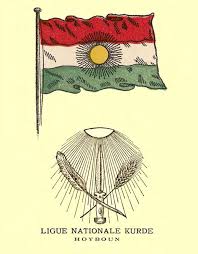
Kemal's Mimicry Must Collapse
Some interested parties, and perhaps also a few sincere observers, are laboring
under the delusion that Kemal, by his studied imitations and affiliations, is
headed toward westernization. (29) The fact, however, is that Kemal is now playing
upon the imagination and sense of vanity of the West solely to command capital
and sympathy to prolong his hold upon his rickety government, while he is building
abridge over Armenia and Kurdistan to the Turanian world. Kemal needs desperately
funds and manpower.
Three points should be made clear for an intelligent appraisal of Kemal's venture.
Fundamentally, the Turk remains unchanged. He is as bloodthirsty and rapacious,
as faithless and lying, as ever. Since 1919, the Kemalists murdered, expelled
or deported over 6,000,000 Greeks, Kurds and Armenians, and robbed them of their
possessions. They enslaved tens of thousands of girls and children. The minorities,
who are guaranteed by the Lausanne Treaty equality, etc., are proscribed officially--in
business and politics. Kemal proclaimed amnesty in 1927 for the Kurds, but those
of them who trusted him have since paid the penalty of their credulity. In 1927
Kemal took a "census" of Turkey, which revealed a population of over
13,000,000. The population of Turkey, Kemal well knows, does not exceed 5,500,000
of which no more than 3,500,000 are Turks. (30)
Turkish currency is represented by something like $70,000,000 worth of paper, and Turkish public debt was in 1923 a little over $791,000,000, both of them unsecured. The outgo of the Government, which is put at $95,000,000, is about 40% greater than the actual income, and nearly one half of the revenue is used for the army. The balance of trade, which is shrinking gradually, is nearly 50% against Turkey. The primitive, inept Turkish people, now reduced to a mere 3,500,000, cannot support their Government, cannot become westernized in a generation or two, cannot increase their productive capacity by the adoption of western codes, and cannot defend so proportionately a great area, such as Kemalist Turkey. (31) The conclusion must be that the Kemalists lack not only character but actual or even potential resources for the maintenance of an independent existence. Kemal must either barter his precarious political independence for loans, or he stands ready to be engulfed in the rising tide of desperation of his own people. How long will he be able to pay and feed his army, upon which his rule rests?
But, if even Turkey possessed, or could possess, the essential moral and material resources to consolidate her holdings, over 6,000,000 Armenians and Kurds would never allow Turkey to enjoy in peace her ill-gotten gains. So long as Kemal is allowed by certain Powers to hold his pretensions over Armenia and Kurdistan, there can be no hope for any serious effort on his part to put his house in order--if any such thing were possible. Kemal must first get out of Armenia and Kurdistan. Westernization of Turkey is a grotesque farce--an illusion. (32)
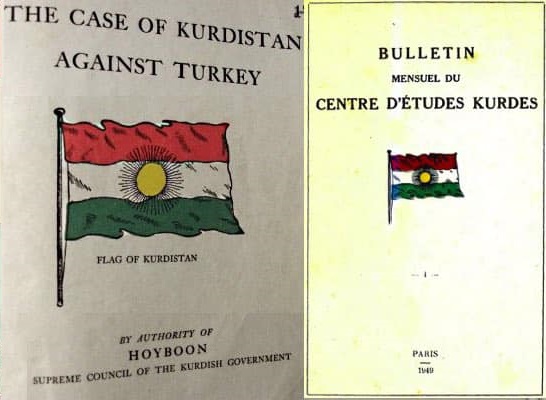
A Last Word
Much as the Kurds would like to believe in the principles of international morality
and justice, as professed so generously and so often by the Great Powers, their
own experience, and particularly the terrible experience of the Armenian people,
at the hands of the Allied and Associated Powers, forbids any further illusions
on that head.
The Kurds are, of course, entitled to material remuneration by the Powers who
have allocated amongst themselves the Kurds' national heritage. Yet, at this
time, at least, they make no claims upon those Powers for any material, much
less, physical, retribution or help in their struggle against the Turks.
They demand, however, that the nations concerned shall observe and respect the
Kurds' territorial rights against turkey, as laid down in the Treaty of Sevres.
They will never recognize any agreement or treaty by or with Turkey affecting
these Kurdish lands.
The Kurdish people, now engaged in a thousand years struggle, which will determine
their racial existence, still believe in the sense of fairness of the great
American people, and, with confidence, submit their case to the conscience and
judgment of the United States.
Issued by The Kurdish Independence League, 655 E. Allegheny Avenue, Philadephia,
Pa.
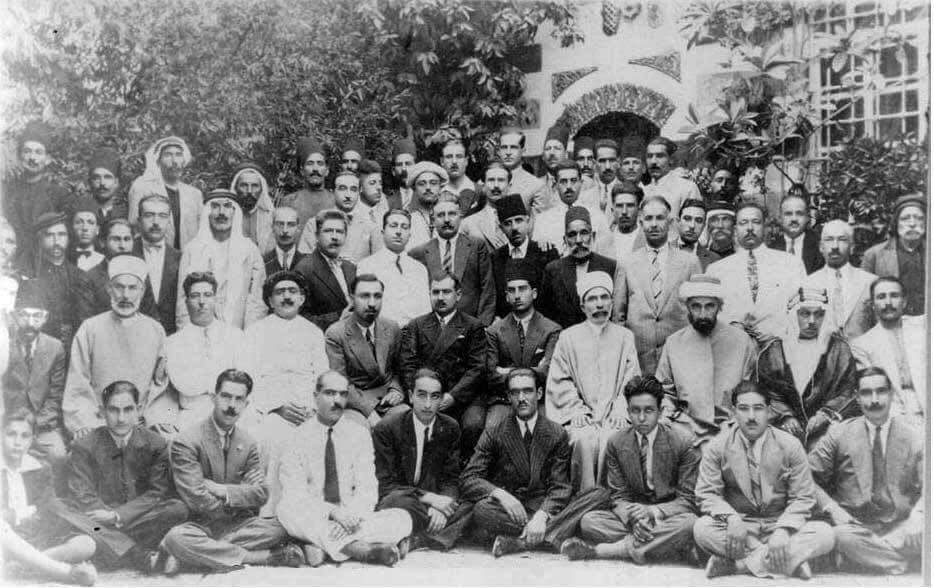
The Kurdish Independence League, Beyrouth
ENDNOTES
(1) Emir (Prince) Sureya Bedr Khan is the elder grandson of Prince Bedr Khan
of Azizan, last ruler of the semi-independent Kurdish state of El-Djezireh,
which was conquered by Turkey in 1847. He is the direct descendant of Halid
Ibn Valid, Chief of the tribe of Beni Kuzeim, at whose hands Mahomet, the Prophet,
suffered his only defeat, and of Abd-ul-Aziz, the grandson of Halid, who conquered
El-Djezireh in the 7th century, and was appointed by Omar, third Khalif, hereditary
Prince-ruler of the conquered territory. Since, in unbroken succession, the
forbears of Bedr Khan, down to his grandson, ruled El-Djezireh.--Ed.
(2) In pre-war Turkey, the American missionaries maintained or supervised 1.049
schools, with an attendance of about 50,000--since reduced to 11 schools, with
an attendance of about 2,500. Formerly, these schools were in truth American
mission institutions; they enjoyed complete administrative and scholastic autonomy,
and the teaching of religion formed, of necessity, the basis of their existence.
Under the Kemalist regime, however, they have become actually Turkified and
secularized. The curriculum and the appointment of teaching staff are regulated,
as those of Turkish schools, by the Turkish government, and the teaching of
religion is forbidden in them. This policy of opportunism has stamped the work
of the missionary as a purely commercial venture. They no longer command the
respect of those whom they have betrayed nor even the confidence of those whom
they are striving to "enlighten."
There is more than a passing resemblance in the situation to the custom of the
Dutch traders in Japan, for some centuries preceding the opening of Japan by
Perry, of trampling upon the cross, in order to gain admittance to the country.--Ed.
(3) A state of famine now obtains in the regions of Iconium, Sivas, Cesarea,
Nigde and Eregli, and the failure of crops is now threatening the whole of Turkey
with famine. The Government has appointed a special committee to study the situation,
and to provide, if possible, food concoctions of cheap and debased matter.--Ed.
(4) Both the fiscal and economic positions of Turkey are hopeless, and is rapidly
approaching collapse. The productive capacity has been reduced, as shown by
all available data, to hardly 25 per cent of the pre-war capacity. The revenues
of the Government, in spite of oppressive taxes, cover only about 60 per cent
of its expenditures, which still remain at the pre-war level, although Palestine,
Syria, Arabia and Mesopotamia have been detached.
The Government has suspended interest and administrative services on the public
debt, and has seized the sources of revenue allotted to the Administration of
the Foreign Debt. (An agreement has been recently effected.) In 1881, Turkey
defaulted on her foreign obligations, amounting to about $1,000,000,000. By
an agreement with her creditors, this debt was reduced to $573,036,170m and
its administration was entrusted to a Committee of the Bondholders, known as
The Administration of Public Debt, to which was assigned certain sources of
revenue.
Indeed, Turkey has never redeemed any part of her public debt--foreign or domestic--and
has repudiated most of the latter, and has never paid interest on the remainder.
The balance of trade has always been against Turkey, and, according to a Turkish
writer on finance, her public wealth, estimated by him at $250,000,000, will
be exhausted within 8 years, at the present rate of adverse trade balance.
The budgetary deficits of the Government from 1909 to 1924 amounted to $1,615,500,000,
which were partly met by loans--foreign and domestic--and requisitions, and
largely by formal repudiation or a mere confession of inability to pay. The
domestic debt is created, not by loans as is customary in civilized countries,
but by inflating the currency, that is, by printing fiat money. Requisition
means arbitrary seizure of property.
If the present Government attempts to balance its budget, even eliminating the
charges due to the public debt, it must either reduce the size of the Army by
almost one-half, or curtail its civil branch by nearly two-thirds. In either
case, internal dissolution, factional strife or foreign aggression would certainly
follow. To borrow in Europe, Turkey must recognize her public debt and accept
the control of foreign creditors over her finances.
During the past three years, the adverse balance of trade has been met by the
sale of "abandoned property," (the property of expelled Christians)
by funds belonging to these Christians and seized from the Banks; by sale of
State property--of the Sultanate and Pious Foundations (Evkaf), and also, by
credits, inspired by the hope of concessions to exploit the resources of the
country ...
(5) The Turks first came in contact with the Arabs in the 7th century. At the
memorable battle of Hehavend (642), Khalif Omar's Army of 30,000 men, under
command of Noman, destroyed Yezdegird's Persian Army of 150,000 under Firuzan,
and then the whole of Persia fell under the Arabs. Yezdegird, however, fled
to Merve, and sought the help of the Turks and of the Emperor of China. The
Turks responded and, for several years, fought the Arabs in the regions of Merve,
but, finally, retired across the Oxus. In 1055, Sultan Toghrul, the Seljuk Turk,
entered Bagdad and was welcomed by Khalif Caim as "Emperor of the East
and of the West." Toghrul married Caim's daughter, and became the temporal
ruler of the dominions of the Khalif.... In 572, Khusrou, the Persian, in revenge
of his defeat by the Roman Marcian of Sargathon, raided Apamea, Syria, taking
292,000 captives, and sent thousands of Christian girls as slaves to the Khan
of the Turks. But in 626, Emperor Heraclius had these same Turks as allies against
the Persian Sahr-barza, and, in consideration, offered the hand of his daughter,
Epiphanea, to the Turkish Zhebu Khan. International morality was not then upon
a higher level than it is today.--Ed.
(6) Cilicia or Seleukia, from the family name of the House of Seleukos, Satraps
of Alexander of Macedon (331-323 B.C.) in Near and Middle East; established
the Seleukid dynasty; ruled in Syria, Persia, and at Bactria; the former merged,
the latter obliterated by Turanians in first century A.D.--Ed.
(7) During the Eastern Empire (959), Asia Minor (240,000 Sq. M.) had a population
of 32,000,000--since reduced to about 3,000,000.--Ed.
(8) The Turks of Turkey are basically of the most primitive and backward branch
of the Mongolian race. Upon that stock is grafted a hodgepodge of renegades,
slaves, captives and forced converts, drawn from all the races bordering upon
the Mediterranean and Black Seas. There is also a large element provided by
black slaves from the Soudan and Central Africa. The piratical monopoly of these
seas, which was held by the Turks for so many centuries, down even to the middle
of the 19th century, was a magnet which drew the lawless and criminal from all
parts of the world. Of this blending of the primitive, the savage, the stupidly
brutal and atavistic products is composed the Turk of today. The retention by
him of his primordial traits is explained by the Mendelian Law, which, as applied
to anthropology, is stated by Madison Grant in the following terms: "...
The result of the mixture of two races, in the long run, gives us a race reverting
to the more ancient, generalized and lower type."--Ed.
(9) In 1914, a society was organized in Constantinople, styled as the Turk Ojak
Society (meaning Turkish Hearth), of which Enver Pasha, the then Minister of
War, became President. The Turks belong to the Turanian (Mongoloid) branch of
the human family. The purpose of the Society was to establish a link between
the Turks of Anatolia and those of the Caucasus and the Transcaspian, and ultimately,
to found a Turkish State, stretching from Thrace to Central Asia.
The Turanians number about 22,000,000. The Turks of Turkey and Southern Caucasus,
4,000,000; Tartars, Kumuks and Noghai of Northern Persia, eastern Trans-Caucasus,
northwestern coast of the Caspian and of the Ural-Volga regions, 4,000,000;
Bashkirs of Astrachan and Ufa, 1,500,000; Turkomans of the eastern coast of
the Caspian, Aral sea, Khiva and northwestern Persia 1,200,000; Uzbeks and Sarts
of Khiva, Bokhara, Tashkent, Pamir and of northern frontier of India and western
China, 3,500,000; Kirghizes of northeastern Turkestan, 5,000,000 and Kashgarlaks
and Taranchys of western China 1,500,000.
All these races trace their origin to the Turanian stock; speak allied dialects
and profess Mohammedanism. The dream of a Turanian empire is a fixed policy
of the Kemalists and is to them a question of life and death. Kemalist agitators,
emissaries, spies, officers and scholars are now feverishly at work, particularly
among the Tartars of Persia Armenia and of Russian Trans-Caucasus. The Turanians
of these regions are being furnished with arms and munitions by the Kemalists
for the day when Turkish "crusaders" will "rescue" their
brethren from alien yoke. The consummation of the scheme, however, requires
not only the extinction of the Armenian and Kurd, but also the submission of
Persia, Russia and Great Britain.--Ed.
(10) Turkish political parties are small personal cliques. They are not parties
in our sense. That of Kemal, launched in 1919, and which is known as the Popular
Party, is composed of a number of officers and officials who were formerly associated
with him in the Committee of Union and Progress, commonly called "Young
Turks."--Ed.
(11) Much of the literature about the pre-history of the Persian, Armenian and
Kurd is founded on wrong guess and Biblical mythology. A great deal of this
misconception must be attributed to an arbitrary association and confusion of
geographical designations with race and language. A distinguished Professor
of history, in a recent volume, speaks of the defeat of Mardonius the Persian
by Pausanius the Spartan at Platoea, in 479 B.C. as "the first great assault
of Asiatics upon Europe." And yet, both Mardonius and Pausanius were Aryans
and spoke allied tongues. We are still limited to unconnected fragments of evidence,
or of negative or presumptive evidence, of a remote and misty age, out of which
we must weave the record. Much of what we think we now know must be, to be sure,
revised, if not in the base, in many particulars at least, in the light of subsequent
research and discovery.
"In the Later Stone Age, presumably in the great plain of eastern central
Europe, between the Vistula and the Volga, the Indo-Europeans dwelt as one people
... Before the dawn of history they began to reak up into distinct groups ..."
(Bender).
We now know that the regions, designated as Persia, Upper Armenia and Kurdistan,
were inhabited for over 6000 B.C by the Medes (Persia) and by numerous clans,
most of which gradually became coalesced into a confederation of States, and
embraced the lands from Ararat, in the east, to the Amanus mountains in the
west. The latter were the Sumerians, or the Ur-ar-du or Ar-ar-du of later Armenians,
centered around Lake Van, and the Accads, or the Cutus of later Kurds or Gordyenes,
who occupied Northern Mesopotamia, around Mosul, south of Urardu. The Hittites held the strip west of Urardu and Accadia. They were all Alpine Aryans, except
the Hittites, who were Anaryans, and spoke allied Aryan tongues, which became
greatly denatured, without, however losing their basic identity, by subsequent
invasions and fusions.
The Aryans, since known as the Cimmerians, who entered southern Caucasus about
1,000 B.C., broke up, under Cyrus, the Median Empire in 538 B.C., and in 226
A.D. under Ardashir, they destroyed the Parthian Empire, which was founded in
250 B.C. in the northeast of Media and Urarda by invaders from the Transcaspian.
Thus most Medes and Parthians became merged with the Persian invader and adopted
his tongue. The Parthian, notwithstanding some arbitrary assumption to the contrary,
would seem to be an Aryan. In the period of his appearance on the scene, groups
of Scythians and Teutonic Alans entered the Caucasus, but we have no record
of Turanian invasion of the Cis-Caspian prior to the extinction of the Seleukid
Bactrian State in the first century A.D. Also, his tongue and the record of
his social intercourse with his Aryan neighbors would place him in the Aryan
family. King Tirdates of Armenia, who established (298) Christianity as the
religion of the State, and St. Gregory, who became the first Primate of Armenia,
and several of their immediate successors, were of Parthian stock. Their available
likenesses and tradition suggest no trace of non-Aryan ancestry.
The habitat of the Kurds, or Gutus, Cudus or Accads, was north of Mesopotamia
or south of Urardu, and touched Media in the east and the Hittite country in
the west. They were racially and linguistically related to their neighbors.
The break-up of the Hittite State (1200-800 B.C.) by the Phrygians and Assyrians,
resulted in the fusion of many Hittites in the Kurds, in the mountainous regions
of northwestern Syria, of which we have living proofs. In the 3rd century B.C.,
all these lands fell under the Parthians, who imposed their tongue, Pehlevi,
which they had adopted from the Persians, upon most Kurds. But those Kurds who
were brought into close contact with the Persian invader adopted a dialect akin
to the Sanskrit of Hindustan, and other further west developed a speech allied
to Armenian. Hence the three principal Kurdish dialects of Kirmanji, Baban and
Zaza. The Sanskrit wa introduced into India by Aryan invaders under Sacae bout
1200 B.C. and was rendered into written form in a book of poems, The Vedas,
about 300 B.C. The word "Sanskrit" is a compound of Sacae and Kir
or kr-el, meaning written in (the tongue of) Sacae.
Almost simultaneously with the invasion of eastern Asia Minor by the Cimmerians,
about the 10th century B.C., an Aryan group from southeastern Europe, the kin
of the Phrygians and Achaeans, progenitors of the Hellenes who conquered Greece
and the Aegean coast of Asia Minor, crossed the Hellespont (Herodotus, Plonius,
De Morgan); reached Cappadocia at the foot of Mount Argue in the 8th century,
absorbed the land of the Had-s, centered in Cesarea (since Hai or High, racial
title of Armenians in their own tongue) which was founded by the Phrygians in
the 12th century B.C. at the expense of the Hittites; and in the 7th century,
pushed their rule easterly towards the uplands. Here they conquered (580 B.C.)
the Confederation of the seven States of Urardu or Sumeria and became merged
and blended with their people. The titles of at least 40 Houses of Nobility
of Urardu were retained by succession down to the Christian period by Armenian
princely families. Emperor Theophilus of Byzantium, of which 10 Emperors, 2
Queens and 2 coregent Sovereigns (etween 582 and 1056) were of Armenian race,
took for his consort (829) Theodora Marinus, "a scion of the great Romanized
Armenian House of the Mamikonians"--(Foord)--a lineal descendant of an
Urardu family of that name.
In the 6th century Persian cuneiform inscriptions of the Achaeanians this land
is described as Ar-mina, hence Armenia. Tigranes I. Of Armenia entered into
an alliance with Cyrus 535-525 B.C. Ar and mina are two Sumerian words meaning
Ar-yan Land. Arar in adopted Armenian means work, create; vod or od, foot; du,
given. Hence Ar-ar-od (Ararat) meaning foot-rest of Creator; Ur-ar-du, given
by Creator. Ar-mina may be a compound, the latter word being the title (Minni)
of one of the States of the Uardu Confederation, or it may be the racial title
of invading Thracians, who had the city of "Armenium" in Thrace; and
later, in the course of their easterly progress named a mountain in Bithynia
"Orminius," and a town in the region of Halys or Kizil River "Armenon,"
now "Al-Liman." As to the Armenian tongue, Prof. Bender makes these
observations: "... It has been thoroughly established by the German philologist
Heinrich Hubschmann that Armenian is an Indo-European tongue and thus belongs
to the same family of languages to which English belongs ... A few Latin parallels
will illustrate the Indo-European nature of Armenian. Compare Armenian berem
"I bear" with Latin fero; ail "other" with alius; araur
(aror) a "plow" with aro "I plow"; akn "eye" with
oculus; malem "I crush" with molo "I grind"; lam "I
weep" with lamentum ..." The Armenian race is, like Central French,
South Germans, North Italians, German-Austrians, most Russians, Rumanians and
Greeks, an Alpine member of the white race (Grant).
The component elements of the three races under discussion are Persian--Mede,
Cimmerian, many Parthians, Semites (Assyrians and Babylonians), some Greeks
(from the Macedonian-Seleucian period, 4th century B.C.), random Armenians and
Kurds. Armenian--Thracians and Phrygians, Urardus or Sumerians, random Medes,
some Parthians, Cimmerians and Greeks, and Latins (during the Cilician Kingdom
(1080-1375 A.D.) Kurd--Accads, some Cimmerians, Medes, Parthians and random
Hittites.
The Georgians, the base of whose tongue is Urardu, are probably the offshoot
of the Urardus, whom the invading Thracians drove in the direction of Choruk
River; the Ossetes, who speak a tongue allied to Armenian, are the remnants
of the Teutonic Alans; and the Lazes of the Barkat slopes, whose physiognomy,
tongue and traditions link them with the Urardus, and allied strains infiltered
through northern invaders by sea.
"These Armenoid Alpines," (Sumerians, Medes and Accads) says Madison
Grant, "possibly invented and developed the Aryan language; introduced
it along with bronze culture into Europe about 3000 B.C.; taught the Nordics
both their language and their mental culture; they made very large contribution
to the civilization of the world, and were the medium through which many advances
in culture were introduced from Asia into Europe ... They brought the nomad
hunters a knowledge of agriculture and of primitive pottery and of domestication
of animals ..."
Fragmentary evidence, however inconclusive, points to these view: In the Later
Stone Age the Aryan race moved both to the West and the East, and the focal
point in the East was the foot of Ararat, as shown by similarity of implements
hitherto discovered in the latter region and in Central and Western Europe;
the current from the East to the West antedated by at least 3,000 years that
from the West to the East, as shown by introduction of metal culture by Alpines
into the West; following the extinction of Chinese civilization, about 7,000
years B.C., which probably reached Mesopotamia, the region of Ararat became
the base of radiation of Alpine-Aryan civilization and of the later Babylonian,
Egyptian and Assyrian civilizations.
The story of the Garden of Eden, watered by certain Four Rivers, leading to
the center of this Alpine country, is apparently an allegorical suggestion or
a circumscribed presumptive opinion as to the birthplace of man and the fountain
of civilization. Jeremiah's call on "the Kings of Ararat, Menni and Ashenez
(of the Urardu Confederation) ... and the Kings of Media" against Babylonia,
and the subsequent alliance (538 B.C.) between the Persian-Median Cyrus and
the Armenian Tigranes, resulting in the liberation of the Jews from 70 years'
captivity, would shed further light upon the mental attitude of the authors
of that story toward the civilizations which then flourished between Ararat
and Northern Mesopotamia. The story about the Ark and the deluge also furnishes
a rational corroborative suggestion in this connection. That story is conceivably
a picturization of Noah's migration, in 40 days, across the desert to Ararat;
his seven months' wanderings in the land of his future home before he could
find a site for his caravan to "rest," and of a state of famine and
pestilence which for 150 days had ravaged the country he had abandoned. The
point, however, of immediate note in the story of the Ark is the suggestion
that there then existed a commanding and comparatively advanced civilization
in the region of Ararat. Unfortunately, much of the record of that stage of
prehistory lies buried in the lands which are still under the power of the Turk.--Ed.
(12) Mahomet, the Prophet, was born in Mecca in 571 A.D.; launched his mission
in 611; died in 632. The Mahometan era begins in 622, which marks the flight
(Hejira) of Mahomet from Mecca to Medina.--Ed.
(13) Khalif Omar, following his victory over Persia in 642, conquered the Kurds;
reduced their land into a tributary dependency, ruled by Empire.--Ed.
(14) Many Kurds, notably the Yezidis, have since clung to their ancestral Zoroastrian
faith, and the Nestorians, who probably belong to the Kurdish race, are Christians.--The
Author.
(15) Sunni, in Arabic, signifies conformist, and Shiite, schismatic or sectarian.
Turks and Kurds are Sunnites; Persians, Shiites. Prophet Mahomet's daughter,
Fatima, married Imam Ai. They had two sons: Hassan and Hussein. Ali became the
fifth Khalif in656. Muavia, who was appointed Governor of Syria by Omar, Third
Khalif, now assumed an insubordinate attitude, and was challenged by Ali to
submit allegiance. Two years' warfare, internecine strife and negotiations resulted
in Muavia's assumption of the dual title of Khalif-Sovereign over the Western
dominions of the Khalifate. Subsequently, Ali was assassinated (661) in the
mosque by an agent of Muavia, and was succeeded by his son Hassan. He was forced
(August 10, 661) to abdicate in favor of Muavia, who ruled for twenty years
(661-680) as the undisputed Khalif of all Islam. Later, at the instigation of
Muavia, Hassan was poisoned by his wife, and his brother Hussein and his entire
family were murdered at Kerbele in 680 by an armed band sent by Yezid, son of
Muavia, then Governor of Syria. From that day on, the adherents of Hassan and
Hussein broke loose from allegiance to Khalif Muavia, whom they denounced as
usurper, and murderer of Ali and Hassan, the true Khalif, and of Hussein--the
only direct descendants of Mahomet the Prophet. They thus assumed the title
Shiite. The antagonism, however, between the House of Ali and Muavia antedates
even the birth of Mahomet, and the Amayades, both descendants of the tribe of
Coreish. Following the fall of Bagdad into the hands of Seljuk Turks in 1055,
and the assumption by Toghrul, the Turk, of temporal power over the dominions
of the Khalifate, the Arabs secretly sent the emblems of the Khalif (robes,
turbans, flags and two strands from the Prophet's beard) to Egypt in 1060. Sultan
Selim of Turkey, upon his conquest of Egypt in 1517, seized these relics, and
every since and down to the abolition of the Khalifate by Kemal in 1923, Turkish
Sultans claimed succession to the Prophet. According, however, to the admonition
of Mahomet, succession must be determined by election. Many interpreters of
the Koran hold that is may be legitimately claimed by a lineal descendant of
the Prophet.--Ed.
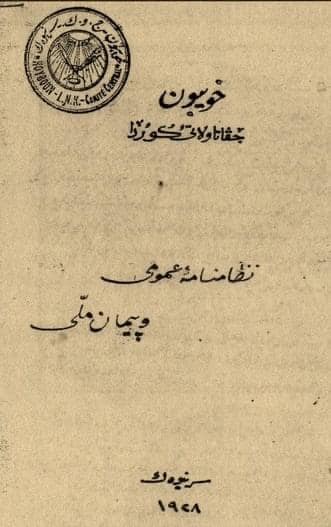
Destûra Rêxistin a Xoybûn'ê.
Civata Welatê Kurd .
Nîzanname a umûmî û Peyman a millî.
1928
(16) Extinction by the Turks of the Kurds' autonomy led to ever-increasing attempts
at rebellion by the Kurds. In 1806 at Suleymanieh, Kurd Abdurrahman Pasha of
Baban destroyed the Sultan's regiments, and pushed his advantage further, but
after two years' unequal struggle, succumbed. In 1812 his son Ahmed Pasha Baban
resumed the fight, and reached the very precincts of Bagdad. In 1920 the Zazas,
and between 1829 and 1839 the tribes of Ravenduz, Hakkiari, Tur-Abdine, Sinjar
and Diarbakir rose in rebellion against the Turks, to be subdued only at great
cost to the Porte. Marshal von Moltke, who was the organizer of the Turkish
Army, and who had witnessed many battles between Turks and Kurds, in some of
his letters to his mother, speaks in admiring terms of the bravery of the Kurds,
but he utters words of indignation and abhorrence at the barbarities committed
by Turkish officers and soldiers upon Kurdish women and children.
The most notable of Kurdish uprisings a against Turkey in the pre-war period
was led, in 1947, by Prince Bedr Khan of El-Djezireh, who had as his allies
many powerful tribes. The Sultan dispatched against Bedr Khan an army of 60,000
men, which was annihilated by the Kurdish allies. A second army of 100,000 men,
under Topal Osman Pasha, was hurled back by Bedr Khan; but when success seemed
within sight, the Sultan sought refuge in intrigue. He bought off Bedr's nephew,
who commanded the left wing of his uncle's forces, with disastrous results for
Kurdish fortunes. Alexandre Zaba in his volume Recueil de Notices et Recits
Kurdes, says that "... the famous Prince Bedr Khan, who successfully fought
Turkish armies in 1847, succumbed only to a ruse by Osman Pasha ..."
In 1875, 1884 and 1889, attempts at rebellion were made by particular Kurdish
tribes. While Turkish titles and gold succeeded in buying the allegiance of
some tribes, others remained unreconciled to Turkish rule. The present Kurdish
rebellion is a revival, on a larger scale than its predecessors, of the Kurds'
determination to throw off the Turkish yoke.--Ed.
(17) Neither Islam nor Turkish rule, however, altered the Kurdish social life.
The Kurds, save possibly a few Turkified Kurds, adhere to monogamy. A woman
goes about freely, and unveiled, except in the presence of a Turk' she enters
into matrimony and enjoys freedom and authority within the home and engages
in social intercourse much the same as the American girl and woman. Divorce
is a rare thing, and is resorted to upon the gravest ground. La Grande Encyclopedie
says: "The sense of honor and family is highly developed among them. They
are sincere, honest and hospitable. Their women are freer than in Turkey and
in Persia; they go about unveiled. Polygamy is never practiced, except by a
few rich. The Kurds detest the Turks. They love music and dance."--The
Author.
(18) In the pre-Christian period, the Armenians worshipped a trinity of deities,
Aramazt (Creator of All), Anahid (justice, wisdom, beauty, mercy), and Vahakn
(power, strength). This theistic conception offered the religion of Christ a
fertile field in Armenia. "Armenia was evangelized by Apostles fresh from
the memory of our Lord, as early as 33 A.D., and as a nation adopted Christianity
and founded a National church in 301, and which has outridden the storms of
centuries and is vital today. Armenia was the first nation to adopt Christianity,
with all that act involved in a pagan world." (From the Harbord Report,
April 13, 1920.)--Ed.
(19) Turkish war losses--those killed in battle or by way of reprisal, and those
who perished from hunger, pestilence and exposure--are estimated at over 2,000,000.
According to the report of The American Military Mission to the Near East, submitted
to the Senate on April 13, 1920 ... "600,000 Turks died of typhus alone,
and not over 20 per cent of the Turkish peasants who went to war have returned
..."--Ed.
(20) On June 23, 1920, Mr. Lloyd George, in the House of Commons, said that
"... the Turkish Treaty was postponed at the request of America. Also Sir
Austen Chamberlain, at Birmingham on Oct. 13, 1923, said: "... The Peace
Conference did not take up the preparation of the Treaty with Turkey until at
a very late stage. That delay in its consequences has been profoundly unfortunate,
and has affected the whole situation. The Allies were encouraged by President
Wilson to believe that the United States would take an active part in the settlement
of Turkey ..."
M. August Benard (Officier d'Academie) in Aiguillon, says: "... France
agreed (in 1919) to dispatch 12,000 troops to the Armenian Republic, and directed
Col. Bromond to organize an Armenian army in Cilicia. Had it not been for the
subsequent intrigues of some of the Great Powers, those measures would have
consolidated and rendered secure the position of the Armenian Republic. But
the United States Government, which had given its assent to our sending troops
to Armenia, informed us a few days later that it itself had decided to send
troops to Armenia. Responsibility for Armenia's plight rests upon America and
England. We will, in due time, return to this subject, and without regard to
protests and denials, make a complete expose of the circumstances which resulted
in the abandonment of our faithful ally--Armenia ..." The delay of nearly
two years, which America imposed upon the Allies, offered the Turks the opportunity
to organize resistance, and deprived Armenia of the opportunity of accepting
the proffer of help which was made to her by the Allies. This policy of procrastination
was wholly avoidable, and was due solely to unconscionable negligence, incident
to partisan squabbles.--Ed.
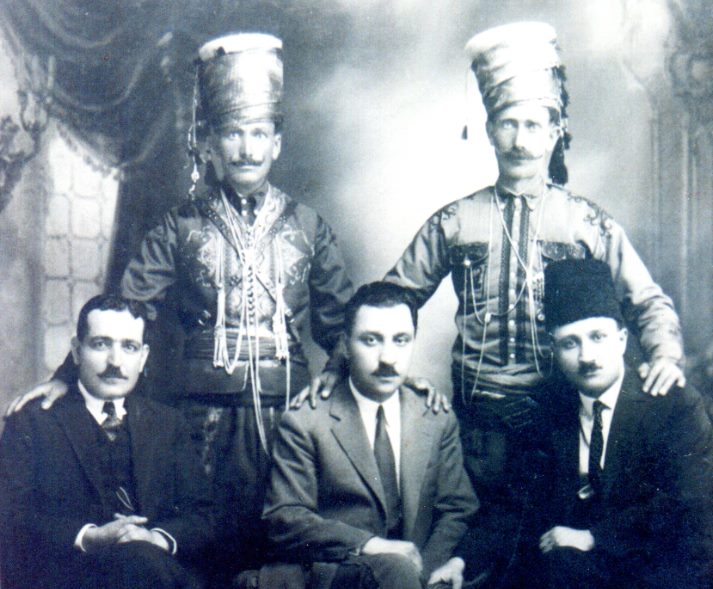
Staying: YADO - The legendary Kurdish Leader - 1925 - Leader of Kharpout front from Cholig (Bingol). Sadin Talha from Cholig (Bingol). Region, Northern Kurdistan
Sitting: Memduh Selim, Jaladat & Kamuran Badir Khan brothers
(21) By the Treaty between Moscow and Angora, the latter represented by Ahmed
Moukhtar Bey, now Turkish ambassador to the United States, a simultaneous attack
upon the Armenian Republic by Turks and Bolsheviki was agreed upon. Also, Moscow
agreed to cede to Turkey parts of the Armenian Republic, including Kars, Ardahan
and Sari Kamish.--Ed.
(22) Armenia lost her independence in 1375, and was subsequently divided amongst
Turkey, Russia and Persia. In 1914, the race numbered 4,500,000 of which a little
over 4,000,000 lived in Turkey and Russia, since reduced to 3,069,000 (estimated).
In the World War, three hundred thousand Armenians fought in the ranks of the
Allied and Associated armies or as independent units, and suffered over one
hundred thousand casualties. After the defection of Russia in October 1917,
the Armenians took over the Caucasus front; fought the Turks for nearly eight
months and, on May 28, 1918, set up a Republic, embracing Russian Armenia. Last
week in May, in five days' battles at Sardarabad and Kara-Kliss, 30 Armenian
battalions withstood 50 Turkish battalions, and, on June 4, 1918, Turkey was
compelled to recognize the Armenian Republic as an independent State. This Republic
was then recognized by Germany and soviet Russia, and subsequently, by the Allied
and Associated nations, including the United States. The Treaty of Sevres (August
10, 1920), to which Armenia was a party, allotted to the Armenian Republic parts
of Turkish Armenia, of which the boundaries were defined. (November 1920), at
the instance [sic] of the Allies, and of Turkey and Armenia, by the President
of the United States. But, in September 1920, Turkey and Soviet Russia made
a joint attack upon the Armenian Republic, and seized nearly two-thirds of it.
Later, in March 1921, Moscow forced the fragment which remained into the Soviet
Confederation, of which "Soviet" Armenia is an "independent"
member--with option to withdraw--if it can.
Commander H. W. V. Temperley, Adviser on boundaries to the British Delegation
at the Versailles Conference, in The History of the Peace Conference (Vol. VI,
pp. 85, 86, says: "In the autumn and early winter of 1920, the Red Army
and the Turkish Nationalist Army simultaneously took the offensive. Kiasim Kara
Bekir (Turkish Commander) captured Kars ... On the other flank, the Soviet Troops,
which had already conquered Azerbaidjan, and were about to conquer Georgia,
invaded Armenia from the Northeast, bringing with them a Soviet Armenian Government.
The Tashnagists (the Party in power) fell, and the Armenian Bolsheviks reigned
in their stead, and it was they who signed the treaty with Kara Bekir ..."
Prof. Arnold J. Toynbee, of Oxford University, in the volume, "Survey of
International Affairs," makes the following observations: "In May
and June 1920, there were Bolshevik uprisings in several districts of the Armenian
Republic. Towards the end of July Moscow sent an ultimatum to Armenia demanding
acceptance of a draft treaty which had been presented to the Armenian Government
in June, but had been rejected by them because it stipulated for the transport
of Russian troops over the Armenian railways (to join hands with the Turks who
were fighting the Greeks). A second refusal was followed by invasion on the
10th of August. Before the end of September 1920, Kiazim Kara Bekir, commanding
the Turkish Eastern Army, launched a surprise attack upon the Armenian Republic
... On the 12th of October, the Armenian forces fell back ... and on the 13th,
Moscow sent an ultimatum to Erivan, which Erivan refused. On the 21st, Kara
Bekir captured Kars, and a Moslem rising in the Alexandropol district, to the
rear of the Armenian Army, forced the Armenian high command to ask for an armistice
on the 7th of November...."
The government of the Armenian Republic, which was ousted from Armenian soil
by turco-Bolshevist allies on July 13, 1921, now bears the title of "The
Delegation of the Armenian Republic," and has its headquarters in Paris.--Ed.
(23) The disputed area of Mosul, which bears the reputed vast oil deposits,
has, according to a Report to the League of Nations by its Commission of Inquiry,
on July 16, 1925, a population of 799,000 of which 520,264 (the Commission lists
the 26,257 Yezidiz separately), is Kurd, and 36,652 Turk. Ismet Pasha, at the
Lausanne Conference, contended that the majority of the population of that region
were Turks; and Tevfik Rushdi, Turkish Foreign Commissar, in his argument before
the Council of the League of Nations in September 1925, qualified Ismet's assertion
by the declaration that the Turks "loved" the Kurds, and that the
latter insisted upon being ruled by their "loving brothers."--Ed.
(24) No census of the Kurdish people has ever been taken, except in the district
of Mosul. There are numerous pre-war estimates and claims ranging between three
and five millions. How many Kurds now remain in Turkey is a matter of conjecture.
A French Government Yellow Book, published in 1892, estimated the Kurds in Turkey
at 3,012,897. General Zendji (Russian) put their number in Turkey, pre-war,
at 2,800,475. A Turkish Government estimate, as of 1914, exclusive of Zor and
Mosul, credits them with 2,527,840.
The Kurds themselves, claim (pre-war) in Turkey: 2,987,960; in Syria, 289,940;
in Iraq, 749,380; in Persia, 1,300,000; in Armenia, 60,000, or a total of 5,387,280.
On November 17, 1924, the League of Nations appointed a Commission of Inquiry
to redefine the Brussels Line in the disputed area of Mosul. This Commission
was composed of Count Teleki, former Premier of Hungary; Mr. Af Wirsen, Swedish
Minister in Bucharest; Col. Paulis of the Belgian Army and was accompanied by
British and Turkish representatives. The Commission spent several months in
the disputed area and thereabouts, and, on July 16, 1925, made a lengthy Report,
in which we find this passage:
"... The Commission of Enquiry states that 'out of estimated total of 3,000,000
Kurds, it is fair to say that 1,500,000 live in Turkey, 700,000 in Persia and
500,000 in the disputed territory. There are a certain number in Syria, but
the number in Iraq proper is insignificant.'" (XIII, 87.)--Ed.
(25) The three Turkish Army Corps were composed of 9 Divisions of Infantry,
or 36 regiments of 27 infantry and 9 artillery. The Turks also sent against
the Kurds three Divisions of cavalry from Kars and Djezireh and six divisions
of infantry, which they had concentrated in the regions of Segert, Mardin and
Mediat, in September, 1924, during the dispute with Great Britain over the Mosul
boundary line.--Ed.
(26) The Kemalists, in an effort to misled world opinion as to the true character
of the Kurds' struggle and to excuse the revolting atrocities which they are
perpetrating upon inoffensive men, women and children, have recently set loose
a flood of propaganda. "The trouble," according to them, "is
only with a group of fanatics who refuse to be 'westernized,' whereas the Kurdish
people 'love' the Turks." The Kurd's antipathy for the Turk is as old as
Turkish rule over the Kurd. They have practically nothing in common. The Turk
is a Mongoloid, speaks a Mongoloid dialect, and has ever held true to the concepts
and ways of his forbears. The Kurd is an Aryan, speaks an Aryan tongue, and
before he fell under the blighting influence of the Turk, he enjoyed a fairly
respectable cultural life. And the Kurd's natural sense of abhorrence of the
Turk has since been reinforced by a deep sense of indignation in the face of
fresh outbursts of Turkish savagery. The Kurdish people are resolved to risk
their existence in the struggle to get rid of the Turk.
As to the character of the Kurdish rebellion, we cite the following Turkish
opinion. After hanging 53 Kurdish leaders, who had fallen into their hands,
the Turkish Presiding Judge at Diarbekir pronounced this sentence upon their
corpses: "Some of you induced by personal egoism, others by foreign counsel
and political jealousies, but all of you motivated by the purpose to set up
an independent Kurdish State, started this revolution. Upon the scaffold you
shall pay the price of ruined homes and of rivers of blood you shed."--From
Vakit, June 20, 1925, Turkish daily of Constantinople.).--The author.
(27) Under date of November 24, 1928, I am in receipt of a Report from the Kurdish
Headquarters which says in part: "... Since last August, the Kemalist Government
has been tearing off their parents Kurdish children under the age of ten, pretending
that they are to be placed in special schools. The panic-stricken parents have
since discovered that their little ones are being sent to Western Anatolia,
and they are forbidden, under penalty of death to make any attempt at communication
with them. Stirred by this ghastly crime, designed to uproot our people, Kurdish
parents are now frantically smuggling their children out of Turkey ..."--The
Author.
(28) The Circassian is an Aryan, and his home is in Northern Georgia, Russia.
Following the Crimean War of 1856, many of them emigrated into Turkey and embraced
Islam. They are distributed throughout Turkey, and number about 150,000. They
are a brave and hardy people of yet primitive habits.--Ed.
(29) Adoption of reform measures and of progressive laws is no new thing in
the history of Turkey. Code Napoleon, known as the Great Codes, was in theory
the law of Turkey since 1839. Kemal, like his predecessors, lacks the will and
machinery to administer justice.--Ed.
(30) On Oct. 28, 1927 a pseudo census "disclosed" a population of
13,649,945 in Kemalist Turkey. This daring discovery astonished even the usually
bombastic Yonus Nady, editor of the official "Jumhouriet." The Statesman's
Year Book (1921 edition) estimates, by districts, the pre-war (1914) population
of Turkey at 20,973,900. In that tabulation, Syria is credited with 2,918,018.
The 1923 French census of Syria shows a population of 2,981,863. That supports
the dependability of the statesman's estimate. Taking, therefore, as a basis
The Statesman's estimate of 1914 and deducting therefrom the populations of
the seceded regions of Syria, Mesopotamia, Palestine and Arabia, the minimum
Turkish war losses, and the Armenians, Greeks and Kurds who have since been
murdered or expelled, there would remain in Kemalist Turkey a population in
the neighborhood of 5,000,000. Education is supposedly compulsory in Kemalist
Turkey. Kemal's Commissar of Education puts (1926) the enrollment in his country's
schools, all grades, at 313,900 pupils, or less than 21/2% of its claimed population;
whereas 28,000,000 students are enrolled (1928) in the American schools, or
nearly 24% of the population. The Turks, like some missionaries, have surprisingly
elastic ideas about figures and morals.--Ed.
(31) H. V. Kaltenborn, associate editor of the Brooklyn Eagle, in a correspondence
dated Constantinople, July 27, 1928, and published in the Eagle, says, in part:
"... Customs duties increase the cost of everything that Turkey needs for
her development. Consumption taxes, government monopolies and the high general
taxes in the Near East raise the cost of living to two and one-third times they
were before the war. This means reduced consumption, poor business, general
hard times for everybody.
"The only solution of Turkey's economic problem is foreign participation
in the development of Turkish agriculture and Turkish industry. The Turks expelled
their traders, artisans and industrial classes--Greeks and Armenians--and have
not yet learned how to manufacture or how to buy and sell. In time, they may
learn craftsmanship and business. For the present they are worse off than any
Near Eastern country.
"There is some progress, not much.; Returning to Constantinople after a
three years' interval, one notes a few new buildings, more motorcars and some
outward evidence that there is a class which can afford to spend money for amusements.
The budget I said to be balanced, but no foreigner trusts government statistics.
For example, Turkey's official census gives the population as totaling 13,900,000.
A foreign expert estimates the total at 8,000,000.
"Not until the Turks become less arrogant about Kemal Pasha's military
success and more critical of his economic failure will they have much chance
to escape from present poverty ..."
(32) Dr. Mehmed Ali, in a November 1928 issue of Ikdam, Turkish daily of Constantinople,
complains that even smaller and poorer countries than Turkey forge ahead, but
that Turkey stands still, and continues:
"... Our country holds important sources of wealth, but we do not exploit
them; we don't know how. Greece has already become our greatest competitor in
tobacco, rugs and similar articles in foreign markets; she invades even our
own market ... Constantinople has been reduced to a mere shadow of Pyraeus ...
Since the day of our independence (1922?) many factories have been set up in
our country--since abandoned ..."
That is a pretty good picture of the Turk's aptitudes and of Kemal's "progress."--Ed
By Prince Sureya Bedr Khan (1)
By authority of HOYBOON
Supreme Council of the Kurdish Government
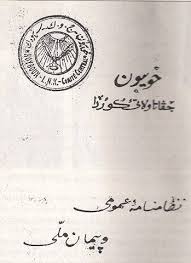 |
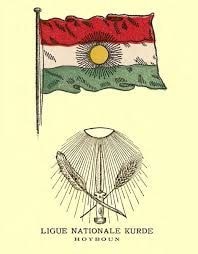 |
Celadet Bedirxan başkanlığında, 5 Ekim 1927 de Kürd Milliyetçi örgütü Xoybûn (Bağımsızlık) Lübnan'da Kuruldu.
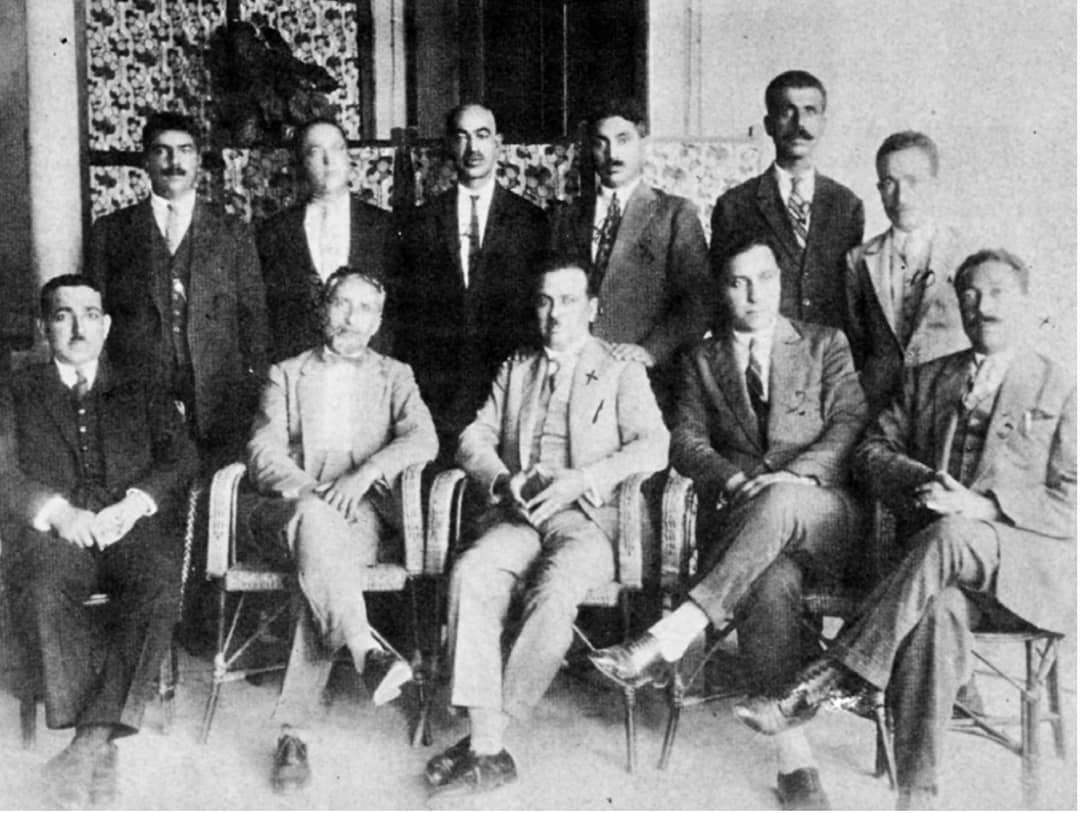
Kürd Milliyetçi Örgütü Xoybun'un liderlerinden Memduh Selim Bey, Celadet Bedirxan ve diğer Kürd liderler...
(Ermeni Devrimci Federasyonu üyesi Vahan Papazyan'da kürd liderlerle beraber),
Kürd Ulusal Davası
Kürdlerin Dünü Ve Bugünü
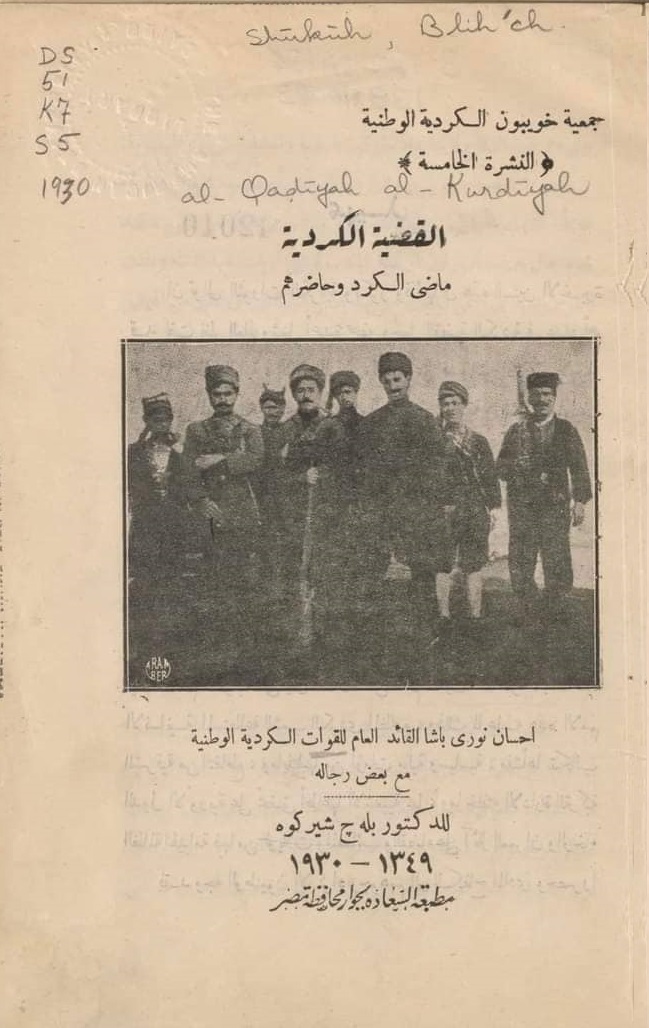
Kürd Ulusal Kongresî Hoybûn Neşriyati
Yazan: Dr Bleç Şerkuh (Süreya Bedirxan)
5. Baskı
Resim: İhsan Nuri Paşa ve askerleri dağ cephesinde
Der Kampf der Kurden, Neue Welt 1929
| Kürtlerin mücadelesi Alman yeni Dünya gazetesi Xoybun röportaji 1929 Küçük Asya'dan şu ilginç açıklama bir süre önce "Berliner Tageblatt"ta yayınlanmıştı: Pek çok sonuçsuz çabadan sonra Kürt gizli örgütü Hoybun'un liderleriyle temasa geçmeyi başardım (Anlaşılacağı üzere adresler t tam olarak bulunmuyor). Burada ilk kez sunulan bu özgürlük hareketinin kökenlerinin tarihi, Emir S. B.'nin iletişimlerine borçluyum, tıpkı bir broşürün taslağının şu anda Arapça, Farsça ve Fransızca olarak basılması ve amaçlanması gibi. Ermenilerle aynı kaderi paylaşan Kürt halkının acılarına halkın gözünü açmak. İlk Kürt siyasi örgütü 1908'de Konstantinopolis'te kuruldu. Liderler Emir Ali Bedr Han, General Şerif Paşa, Ahmed Zülkef Paşa ve 1925'te Diyarbekir'deki Kürtlerdi. Senatör Seid Abdel Kader'i idam etti. Aynı zamanda Konstantinopolis'te bir propaganda örgütü ve bir Kürt okulu kuruldu. Askeri isyanın ardından Jön Türkler okulu kapattı ve tüm Kürt örgütlerini dağıttı. O zamandan bu yana Kürtlerin herhangi bir siyasi faaliyeti ancak gizlice yürütülebiliyordu. Mustafa Kemal'in zaferinden sonra dağıtılan Kürt bağımsızlık komiteleri faaliyetlerine devam etti. Bu bireysel örgütler, birleşik Federal Hoy-bun (bağımsızlık). Türk baskı yöntemleri 1925'te ilk büyük Kürt devrimine neden oldu; onların liderleri oldu Aynı yılın 21 Mart'ında çoğu Türkler tarafından, dudaklarında Kürtlerin özgürlük sözüyle birlikte asıldı. 1925-1928 yılları Kürtler için korkunç zulümlerin yaşandığı bir dönemdi. Bu yıllarda iletişimlere göre Hoybun "8000'den fazla kürt köyü ve 15000'den fazla kadın ve kürt çocuğu Türkler tarafından yok edildi.. Yarım milyondan fazla Kürt'ün sınır dışı edildiği söyleniyor, tüm zorluklara rağmen başardılar Kürt devrimcilerini 1927 baharında yapılacak bir kongre için delegeleri toplamaya çağrı yaptı; Bu kongre Kürt dağlık bölgesinde gerçekleşti. "Hoybun" örgütü kuruldu ve muhtemelen son Türk askerinin Kürdistan'dan sürülenceye kadar mücadeleye devam etme sözü verildi.Yeni devrime hazırlık olarak yüksek komutanlıkların oluşumuna ve silahlanmaya tüfeklerle ateş açıldı. Ayrıca, Kürt dağlarında özgürlük mücadelesinin üssü olarak eğitim kampı olarak planlanan askeri merkezi inşa edildi.Türklerin tüm iddiaları karşısında Hoybun, Kürt birlik hareketinin kararlılıkla yürütüldüğünü garanti ediyor. Hiçbir yabancı parti (İngiltere dahil) tarafından desteklenmemektedir ve Hilafet fikrini destekleyenlerle ya da anti-Kemalist partilerle hiçbir ilgisi yoktur. Kiş servisinde görev yapan Kürt genelkurmay başkanı B'den Ehsan Nuri Bey 1925'te Botan dağında bir ayaklanma örgütlemiş ve daha sonra birkaç yüz takipçisiyle birlikte Ağrı'ya geçmiştir. Agri Dağ devrimcilerinin delegesi sıfatıyla Kürt Kongresi'nde yer aldı ve isyan hareketinin örgütlenmesi konusunda ona güvenildi. 1928 yılında kendisini birkaç bin kişilik iyi donanımlı ve disiplinli bir Kürt ordusunun başında bulundu.Aynı zamanda İbrahim Paşa komutasındaydı. Haski Tello sivil bir yönetim kurarak dağlara Kürt bayrağını astı. Türkler bundan rahatsız oldu Yayılmaya devam eden Kürt propagandası ehsan Nuri Pase ile müzakerelere girmeye çalıştı. Eylül ortasında onunla görüşmek üzere Şeyhli Keupru'ya bir heyet gönderdiler. Çeviri: Bedran Doko |
